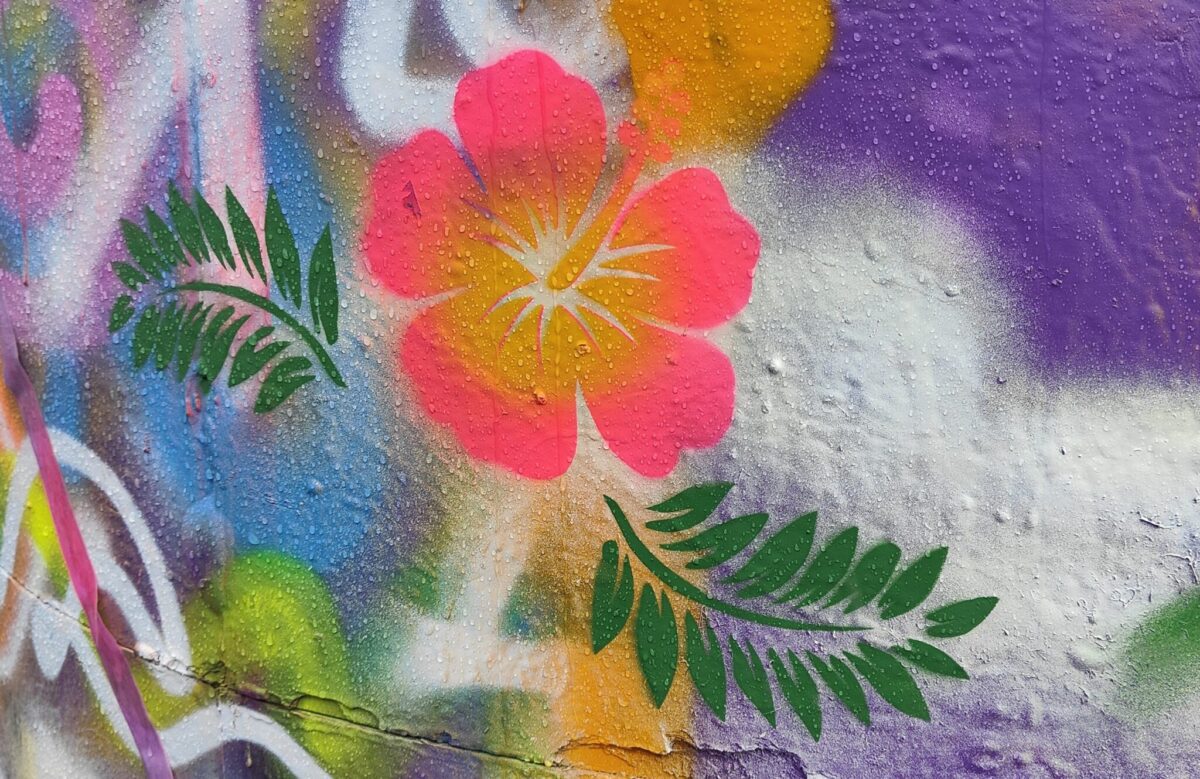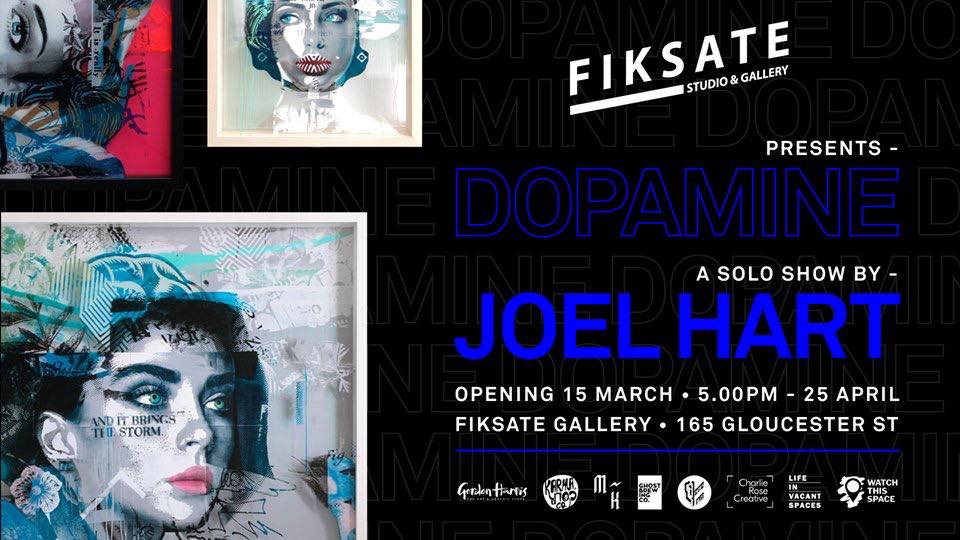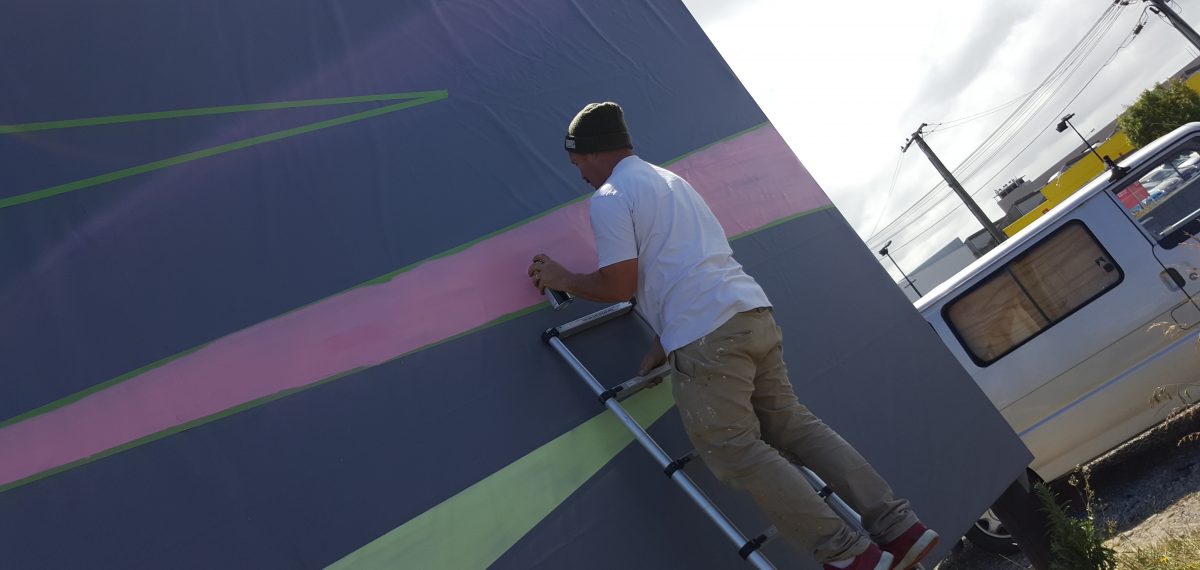With the upcoming refresh of the three ‘permanent’ art cans at the St Asaph Street Giant Spray Cans site, we have been thinking a lot about these unique surfaces and their evolving appearance. While the three cans to the west serve as commissioned installations, with a revolving roster of artists and crews decorating the cylindrical forms, the other three cans, situated to the middle of the space (closer to the basketball court) are a type of legal wall space, an open source option for people to adorn with markings and makings of all kinds. The impact of each set can be strikingly different. The cohesive ‘permanent’ designs serve as aspirational inspiration, but the more haphazard patina of the ‘legal wall’ cans can be equally as interesting – from signals of presence to gestating visual ideas, the cacophony of tags, handwritten messages, characters, patterns and icons are a wide gamut that becomes a thick layer of paint.
Continue reading “The Giant Cans – Notepad, Incubator, Constantly Changing Canvas…”Tag: Stencil Art
Photo Essay – ‘Street Stencils’ by BOLS
At the risk of losing the graffiti purists in the room, while the rebellious and dynamic aesthetics of graffiti were an awakening of how art could be more than what I had experienced as a child, it was stencil art that was a better fit for my personal mode of expression. There are numerous reasons; from the punk aesthetic of early styles, to the specific yet expansive potential of the process. It still embraced the physical nature of aerosol (hard and soft lines, over sprays), but there were also the intricacies of cutting, breaking down an image, and the plates that became stratified objects of interest themselves (from plastic sheets, to light card, or even cereal boxes, the chosen material reflects an important aesthetic decision). Importantly, there was also a conceptual aspect, beyond the stylistic and procedural; something harder to express but imbued within the apparent urgency of street stencils.
While I have spent many hours in small studio spaces cutting and spraying stencils, frustrated at the things that go wrong, exhilarated at the discoveries that unlock new directions, there is something about the presence of stencils in the streets, sprayed directly on rough concrete or worn surfaces. Street stencils are a contemporary incarnation of a primal mode of expression, utilising new cultural references and tools to navigate the current landscape, while exuding a sense of a longer, often political, always existential, lineage.
While it may be the accessible, iconographic visual language stencil artists have harnessed (such as the pop culture imagery almost universally favoured by stencil artists still finding their style) that attracts many, for me, it is this connection to history, the sense that a stencil still represents rebellion, revolution and anarchy. Furthermore, the mechanical nature of the process renders stencils democratic; anyone can cut a stencil and produce an image. Of course there are stencil ‘superstars’, but there are also countless anonymous stencils, reveling in that anonymity and the act of painting in the streets.
The following images have been taken from the last decade, from Ōtautahi, around Aotearoa and even abroad. Some are by well-known artists, others are completely anonymous. Some are fresh and sharp, others faded and obscured. Some are sprayed on surfaces that make the image harder to comprehend, others play off the graffiti covered walls. Some are figurative, some use phrases, some are explicitly political, others harder to decipher. But each is an example of someone acting out, becoming part of that lineage and grasping the inherent qualities of stencils…
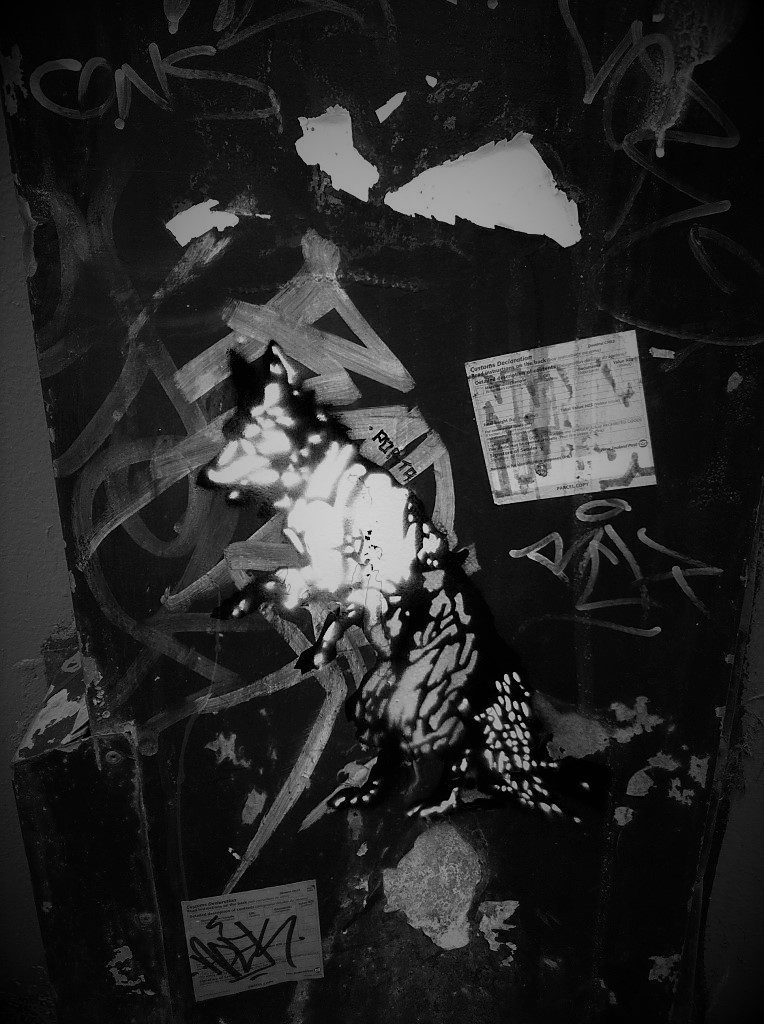
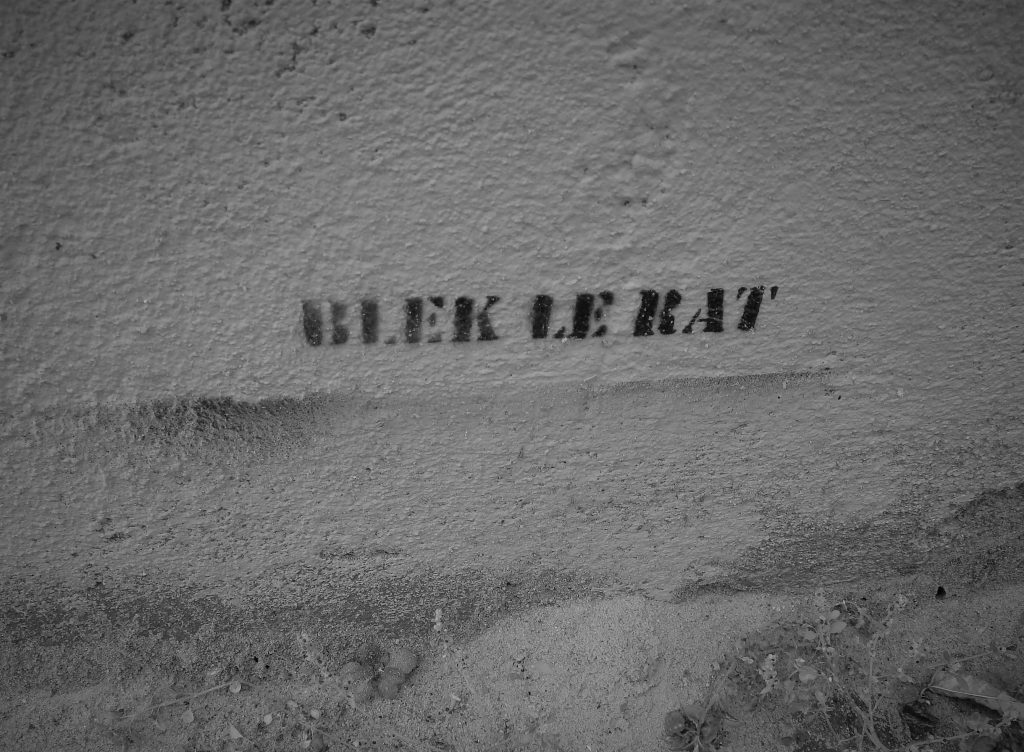
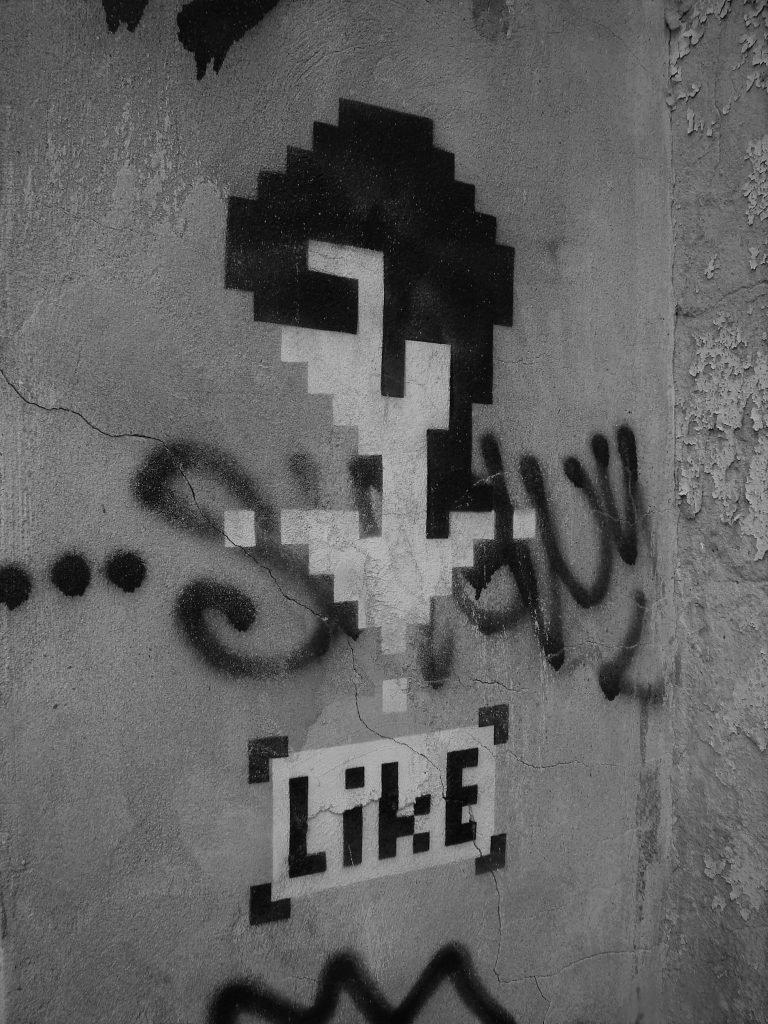
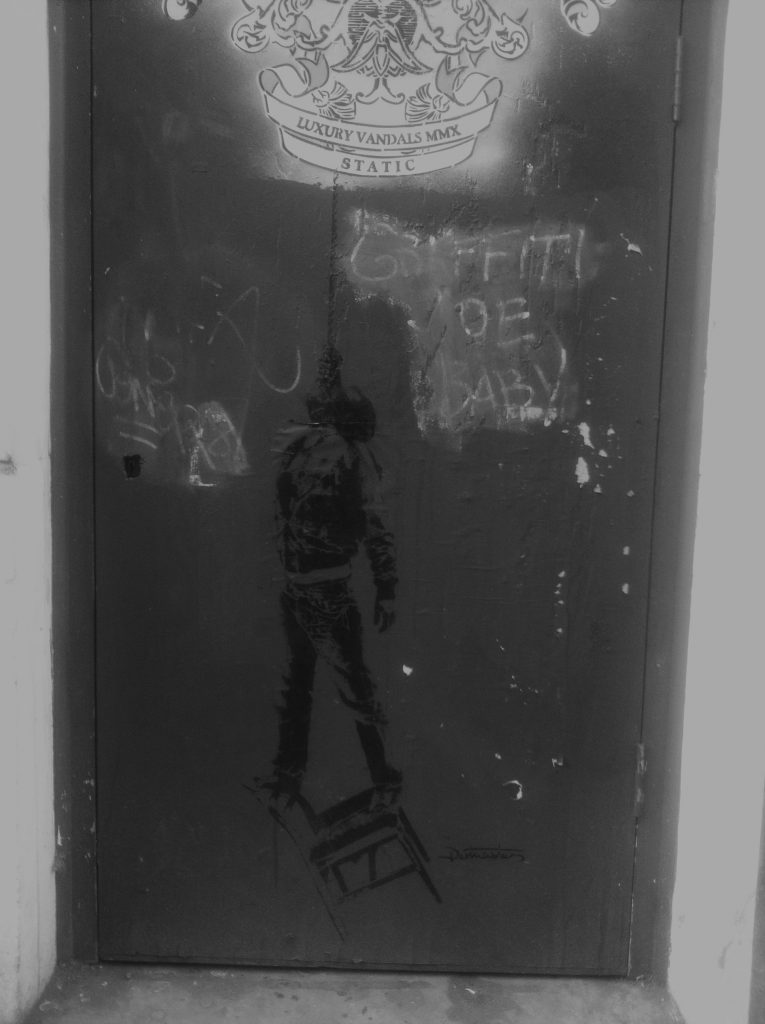
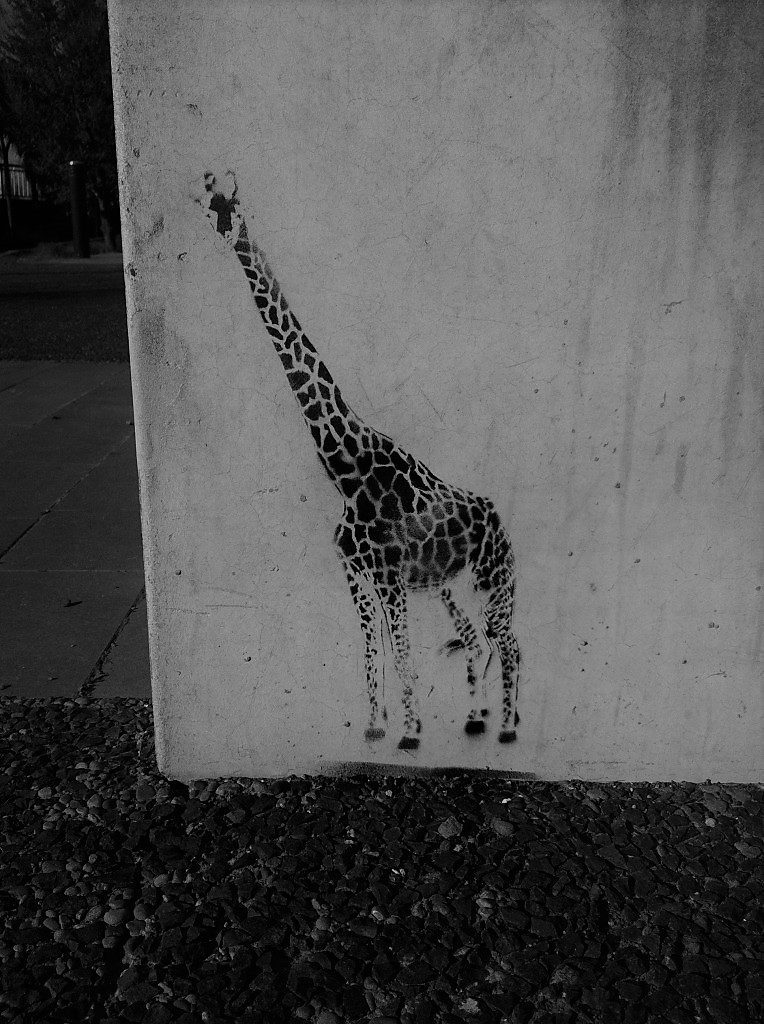
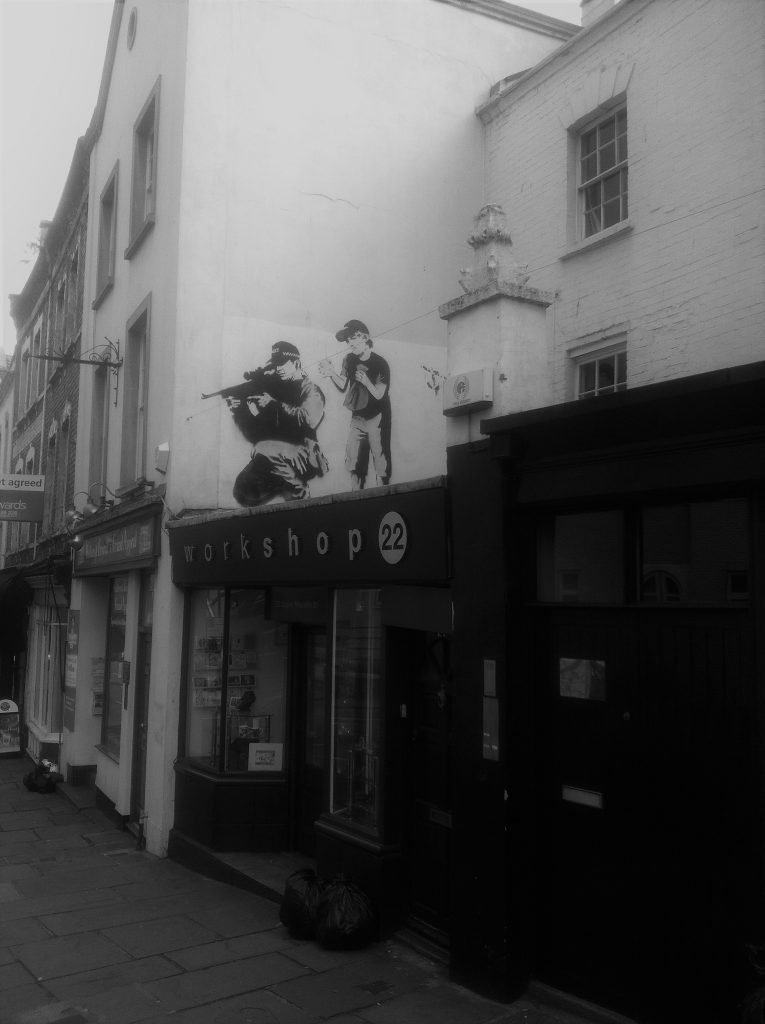
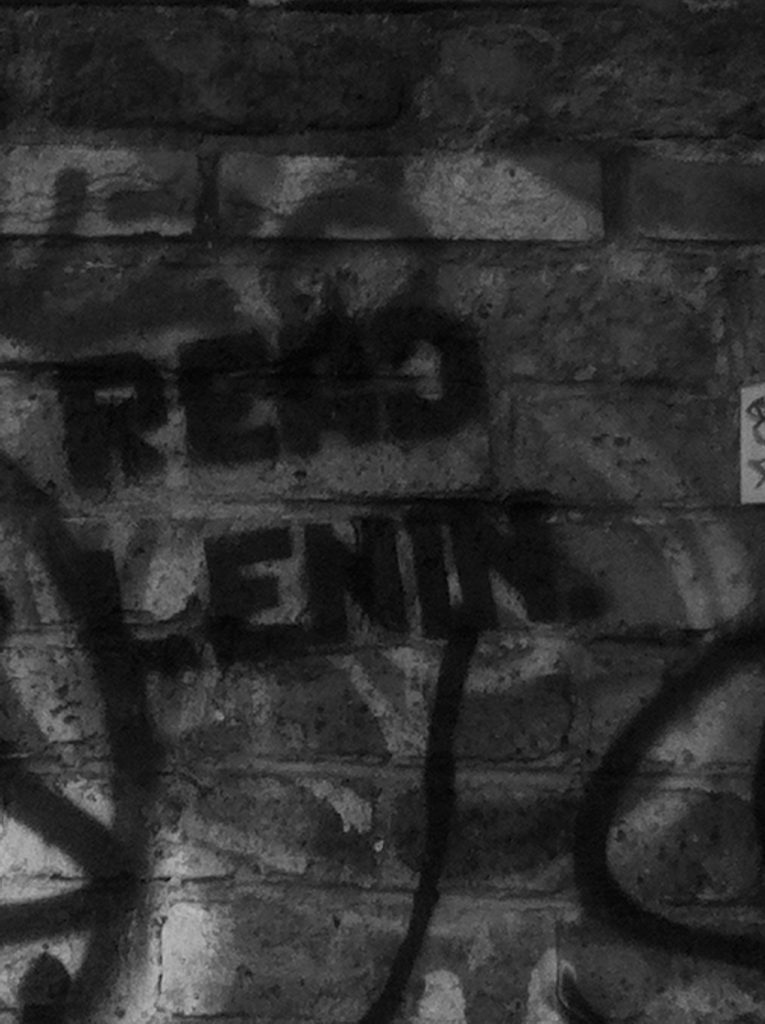
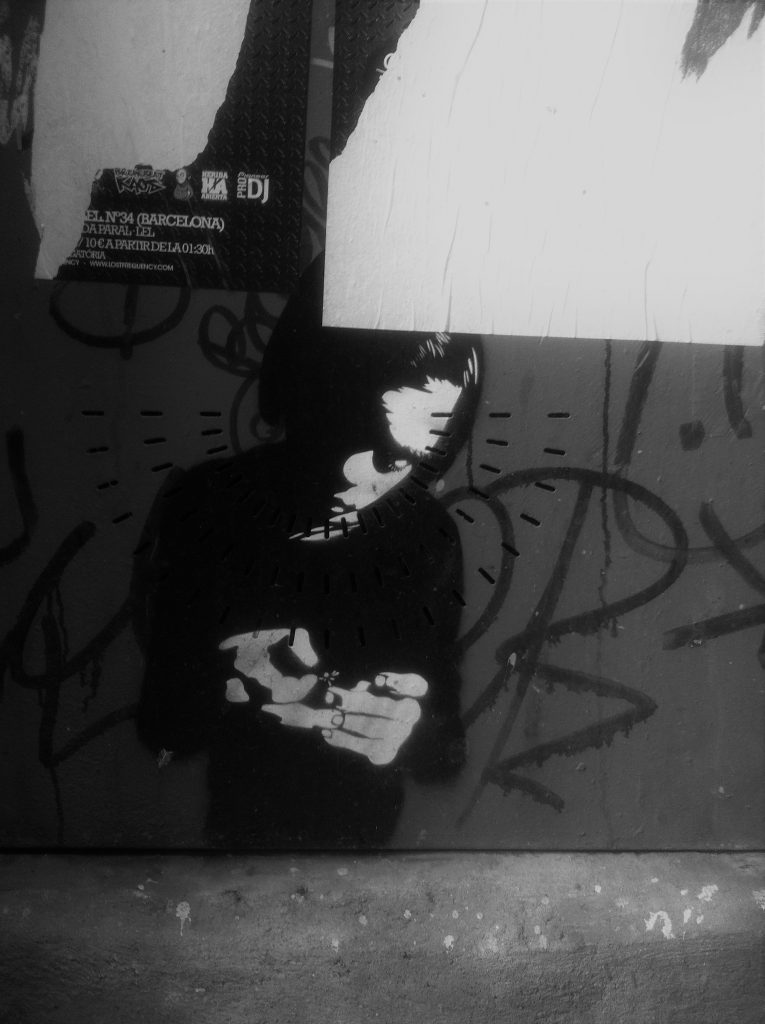
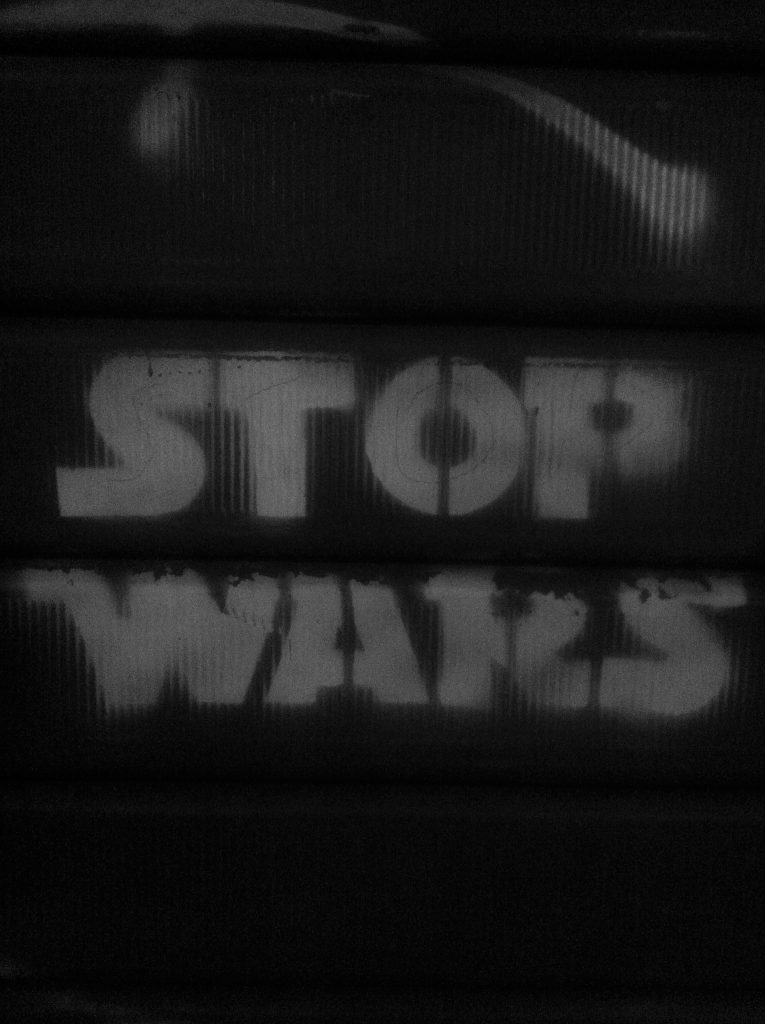
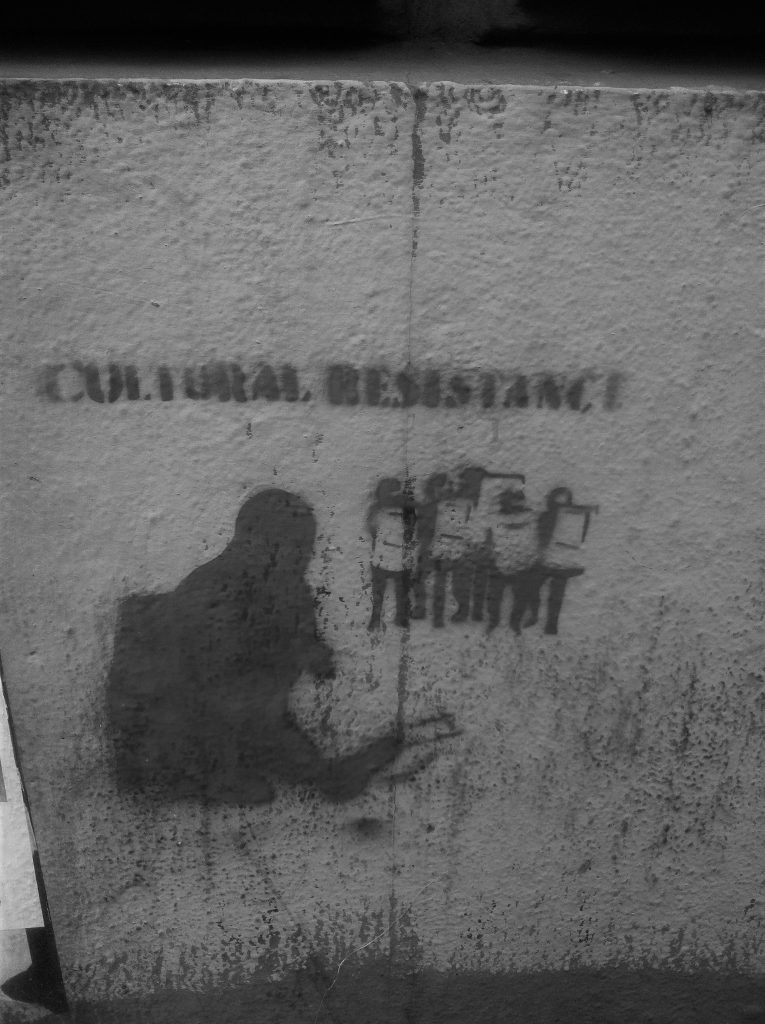
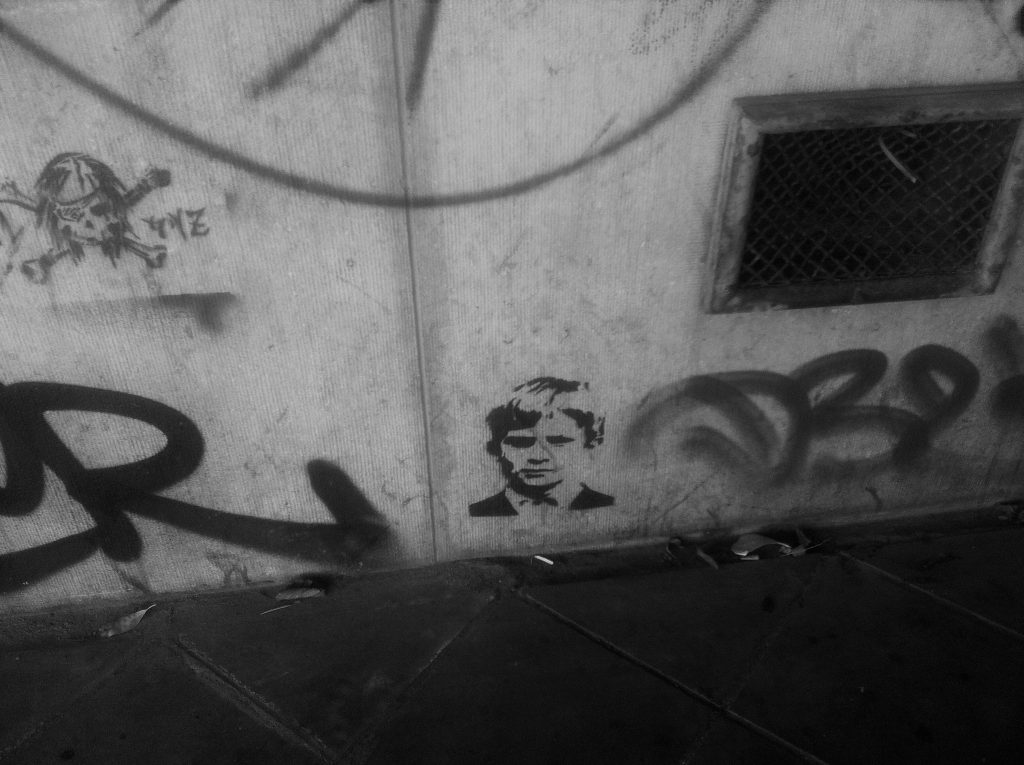
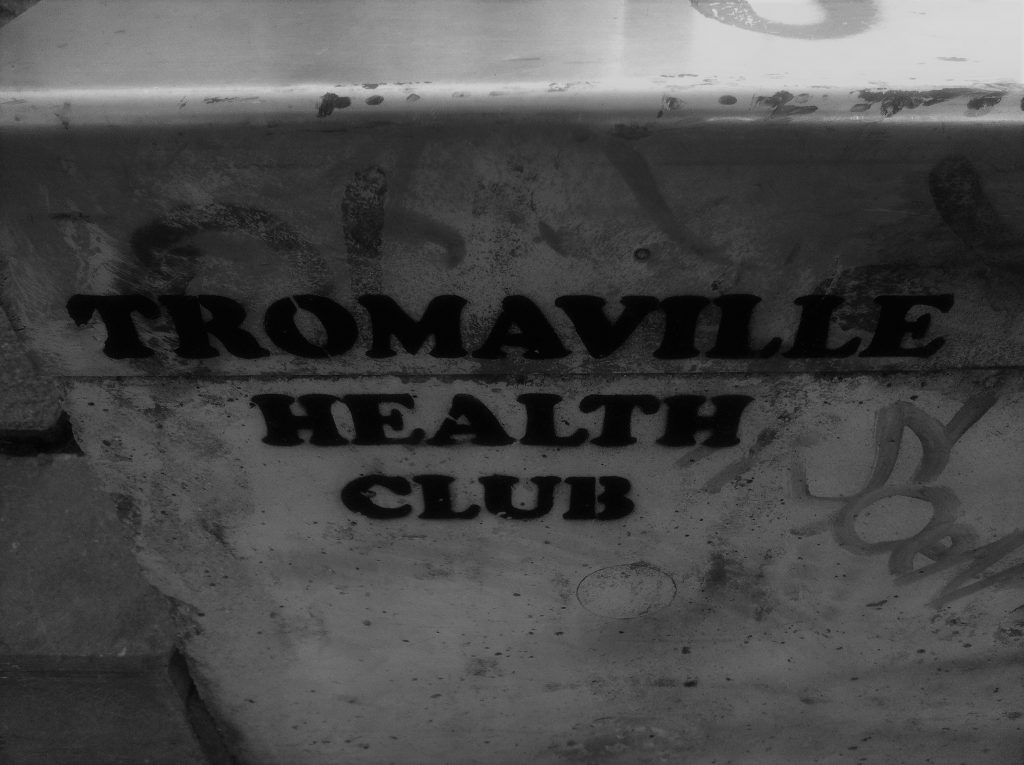
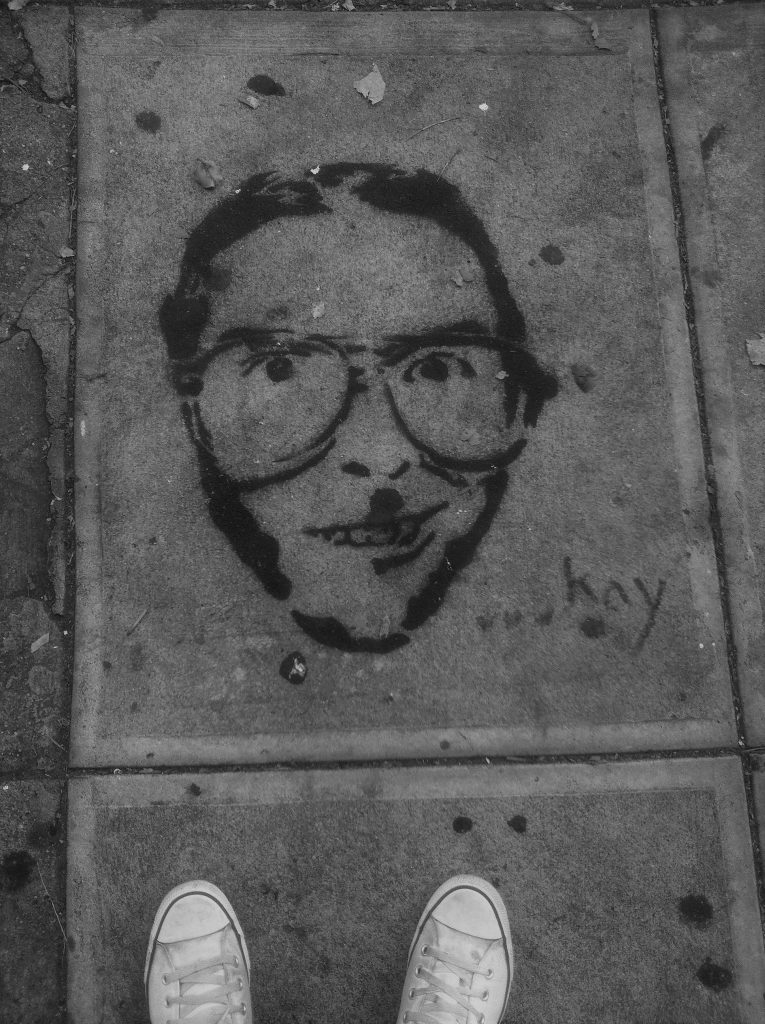
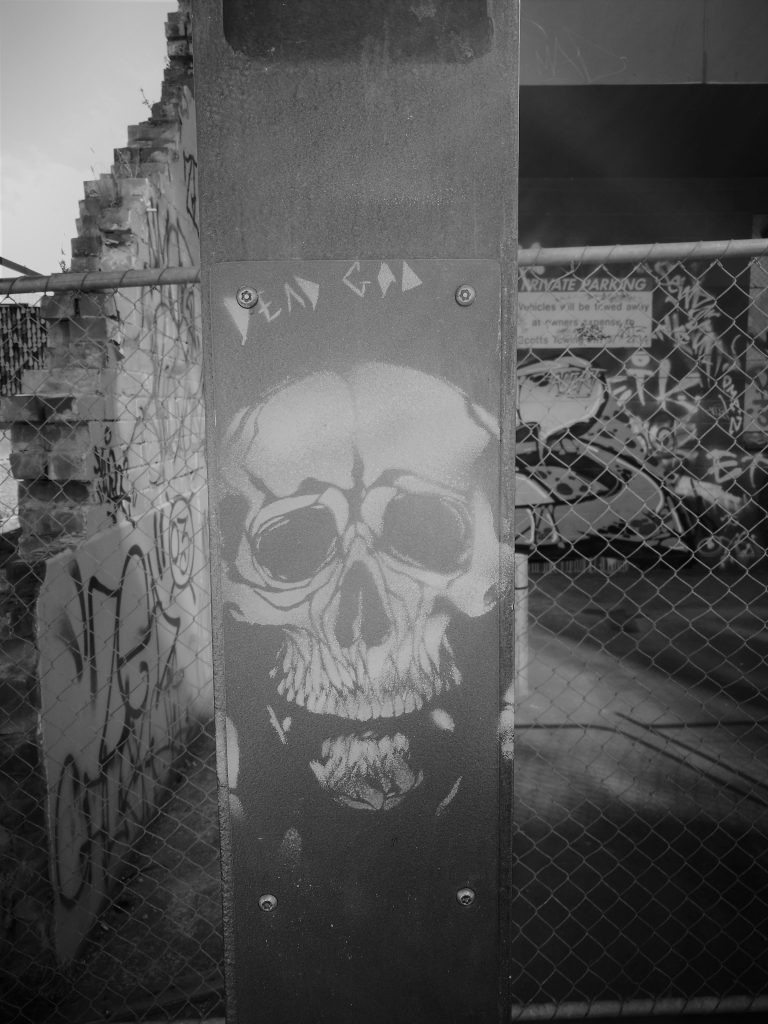
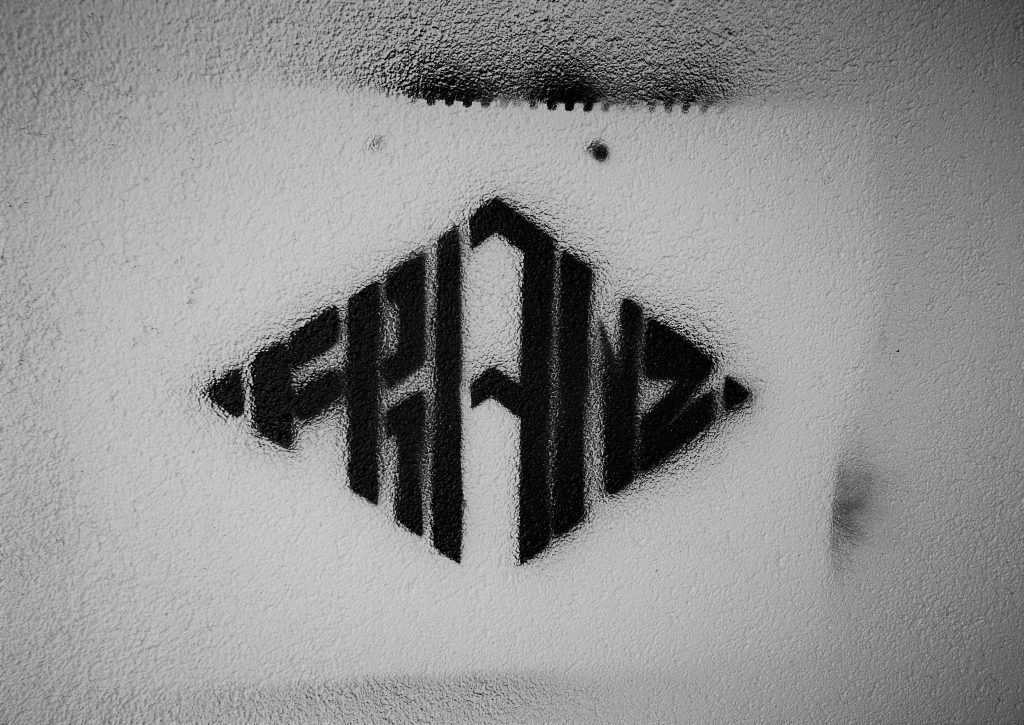
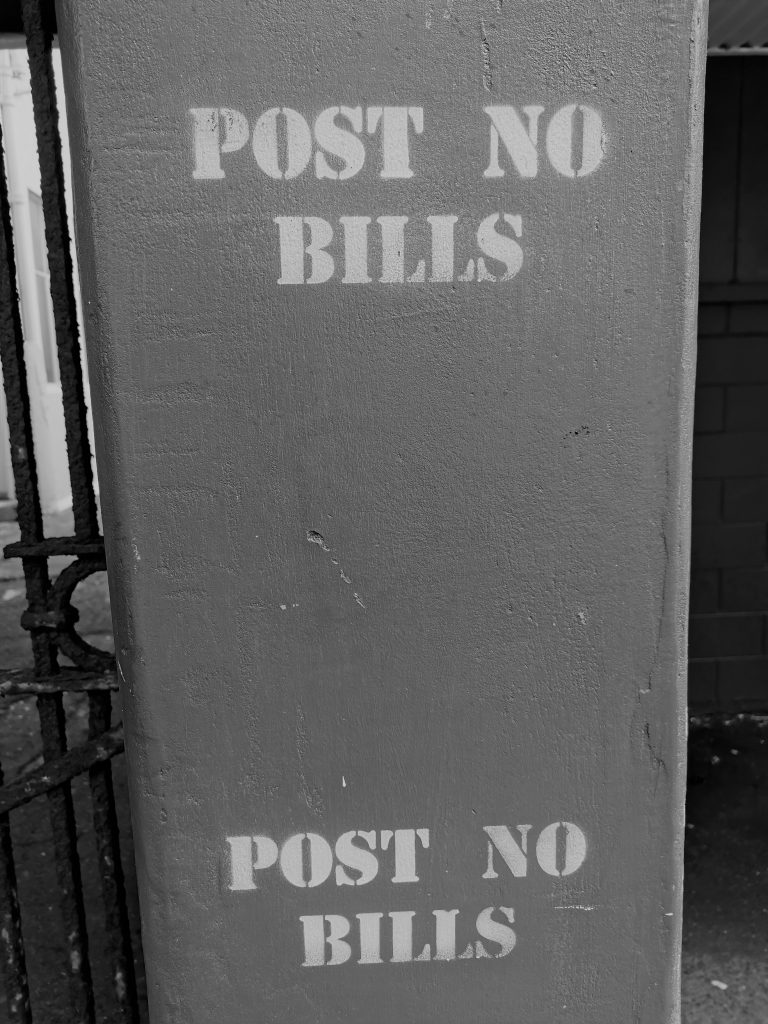
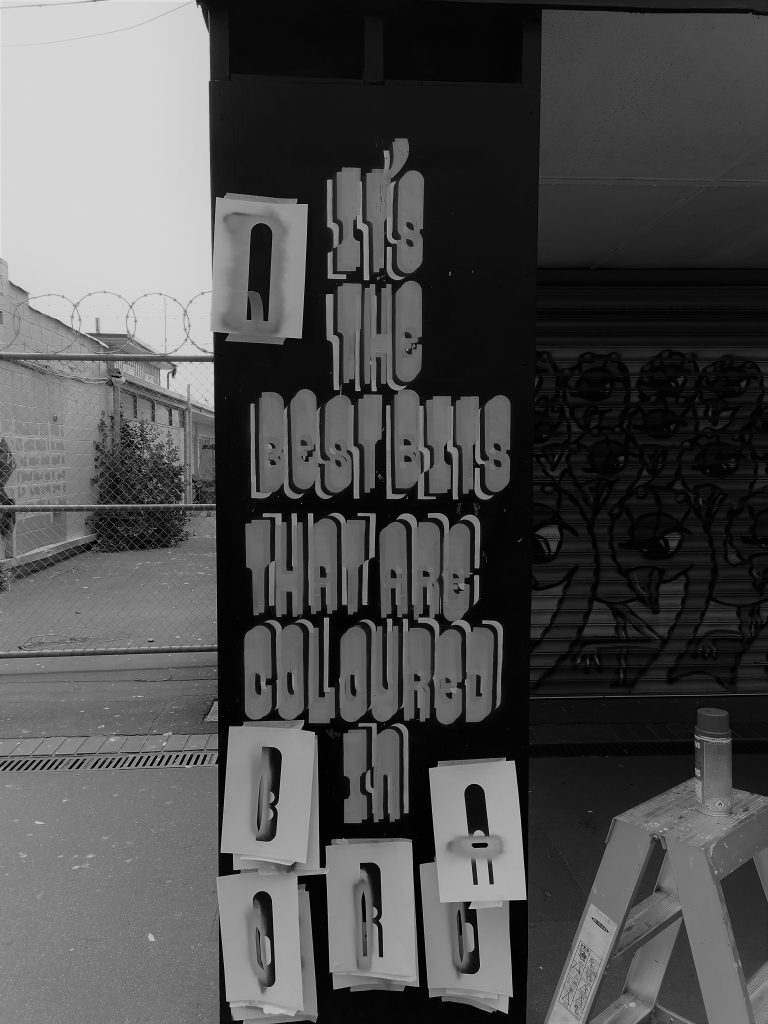
Follow Bols on Instagram
If you have an idea for a Photo Essay, let us know! Email submissions or concepts to [email protected] or contact us on Facebook
Joel Hart – Dopamine
In basketball they talk about being a triple threat: a player who can score baskets, defend, and provide assists for others. This concept is fitting when it comes to Christchurch artist and designer Joel Hart, not just because he has his own history in the sport of hoops, but because he is also a true all-rounder. A talented and popular artist, whose captivating work is found on walls both in the streets and in galleries, he is, to top it off, a heck of a nice guy, unassuming and relatable. It has been a goal to sit down with Joel to discuss his work and career for a while, and the opening of his new show Dopamine at Fiksate provided a perfect opportunity. For an artist whose work embraces a number of processes and materials, and as a figure who perhaps represents an alternative entry into the worlds of muralism and urban contemporary practice, there was no shortage of conversation…
What was the inspiration for the title of this show, Dopamine?
Where did it come from? I can’t actually remember…
I did a bit of research, and from what I have read, bearing in mind my limited scientific knowledge, dopamine refers to chemical neurotransmitters in the brain and they impact a range of emotions and capabilities, including the ability to see and obtain rewards, which was interesting to me, is that what you had in mind when you came up with the title?
Yeah, it is that idea of the visual experience, when you see something cool, and it releases that dopamine feeling, and I guess that’s how I like to explain my work, it’s very much about a visual experience…
You see your work as a very visual, visceral experience, and the immediate response triggering an emotional response?
Yeah, I think so, so that’s where Dopamine came from.
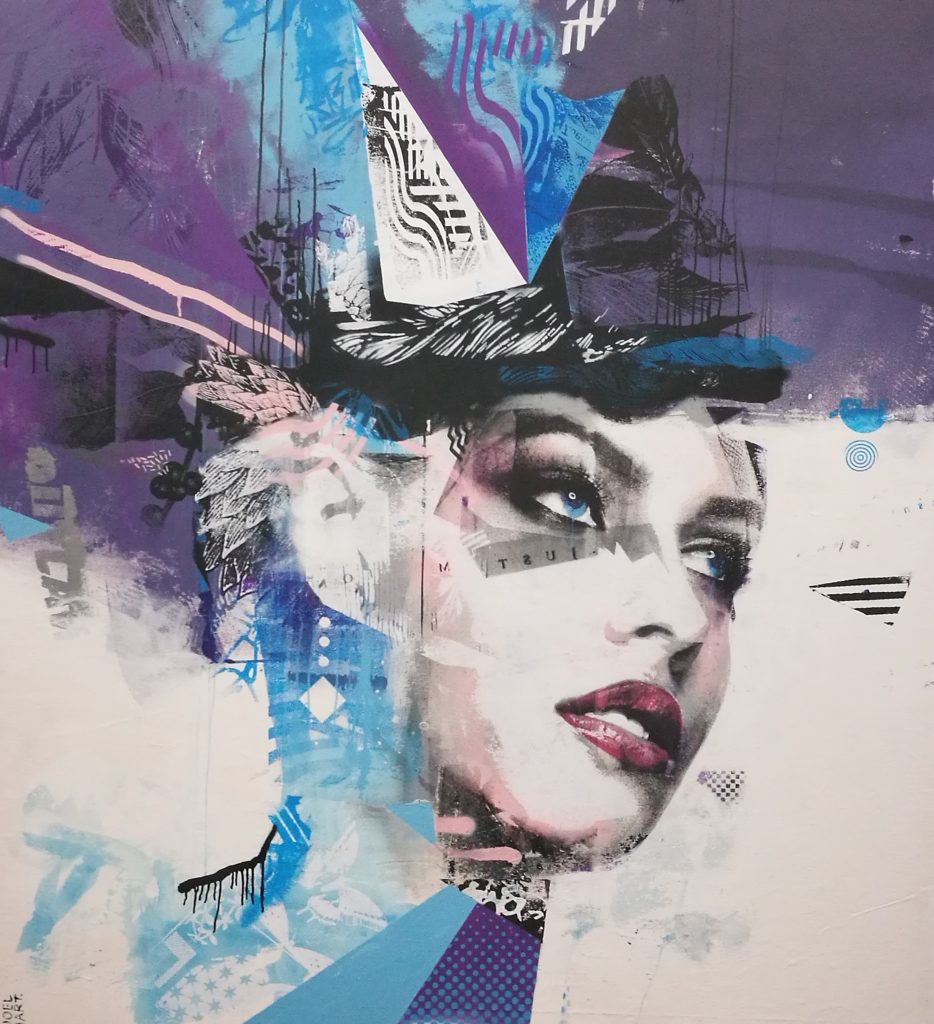
The show opens March 15th at Fiksate, and having talked to you for a while about a solo show, it feels like a long time coming, do you feel that way?
Yeah, it has been over three years since I had my last solo show, so all these ideas that I’ve been pulling together, it has been a long, long time coming. But it also feels like it has snuck up really quickly as well…
That long gap must mean there has been a fair amount of progression in your work, which must be more satisfying than successive shows of the same stuff, but at the same time, it must mean that there is a lot to try and condense into one coherent show that explains that progression. The ability to have a solo show in a dedicated urban contemporary space, like Fiksate, must be satisfying too. Did you feel a different responsibility than you feel painting a mural, having work in a group show, or even a booth in an art fair, a responsibility to have a more coherent, cohesive body of work and presentation?
Yeah definitely, you want to be tying it all together as a consistent body of work, which is really hard to do, because I’m constantly working with a lot of different materials, I’m pushing towards sculptural elements, there are layered works, and there are works on metal as well. I’ve tried to work around the female portraits, which is mainly what I do anyway, so that consistency ties it all together, the themes are similar…
The female face has long been a central icon of your work, what is the allure? Is there an inherent commentary?
I was thinking about that the other day, and it sort of stems from my journey as a graphic designer building into the art works. I’ve worked for magazines, I’ve done a bit with photographers and fashion magazines, I worked for a student magazine as well, which was more of a grungy, underground culture, and then I’ve worked in screen printing as well, so it all plays a part, and the images I work with have come from various elements of all of those worlds and experiences…
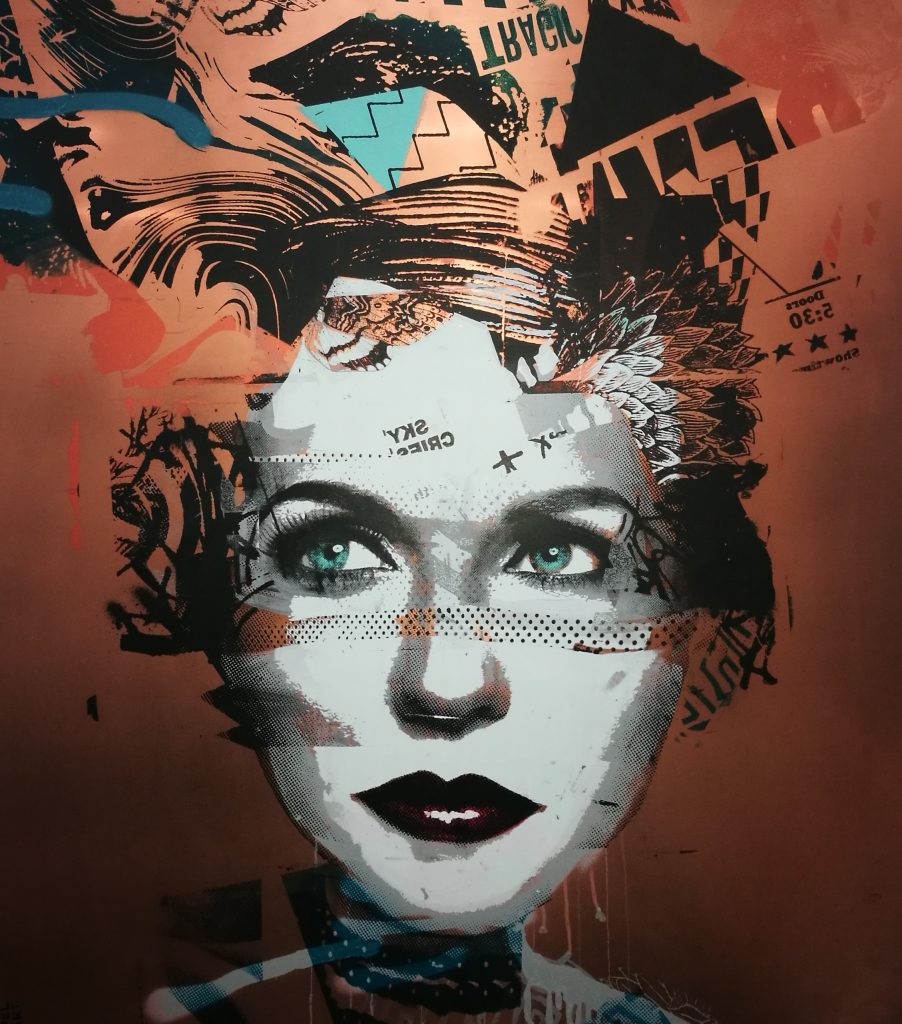
Does the imagery work in relationship with the formal material approaches? The use of layers, the reflective surfaces, the fragmented effects, do they intentionally combine with the beautiful faces, and the other references to make a statement?
Yeah, a little bit, the faces come from a way to build on my stencil stuff. The face really builds the emotional quality of the works, and that’s why I started to build around those images. That probably doesn’t answer your question!
Are the faces you depict drawn from media, like magazines or advertising?
Yeah, a little bit, I suppose that is my background, commercial art, design…
Have you ever considered photographing subjects yourself?
It has always been on the list of things to do. At the moment I just destroy magazines and images and signs and that sort of stuff and fuse it all together. But maybe being able to focus on a specific angle I want, or a look that I want, and being able to build around that from the start will be a lot easier to make a more consistent look, rather than pulling a lot of stuff from everywhere. Sometimes it is hard to build a narrative around a piece when you’ve got all this stuff floating around. I could pretty much build an image from this room, I will see it in my head, all the objects and signs and textures around us, I will pull it all together, but I guess I have always tied my compositions together by building them around faces.
I recently saw a newer work of yours that depicted a male figure, is that a first? Is there a reason the female face has been a more prominent motif?
I’ve done probably half a dozen male figures, but probably most of my work features female figures. I guess I kind of feel like you get more emotion from female eyes, especially in high fashion photography, the lips are more interesting, I don’t know, I guess that is what I’m more interested in working with. Some of the recent stuff I’m playing with allows me to see my work as a snapshot of a larger story, some of the works in this show have a broader narrative, and the faces I see as just something more to explore the formal elements I’m working with…
Those other elements include text, skulls, animals, patterns, natural elements like flowers and foliage, so what is the relationship between all of those aspects, especially the text, it often seems that a piece of text will have an apparently evocative connotation, but at the same time they can be quite ambiguous in relationship to the other pictorial elements, there is a duality between meaningful and meaningless…
Yeah, I quite like to do that, I will have this idea for the visual side, and then I might hear a line in a song, or see something written in a book, just something small, a couple of lines or something, and I will cut it out, and then the text takes quite a prominent role in the piece.
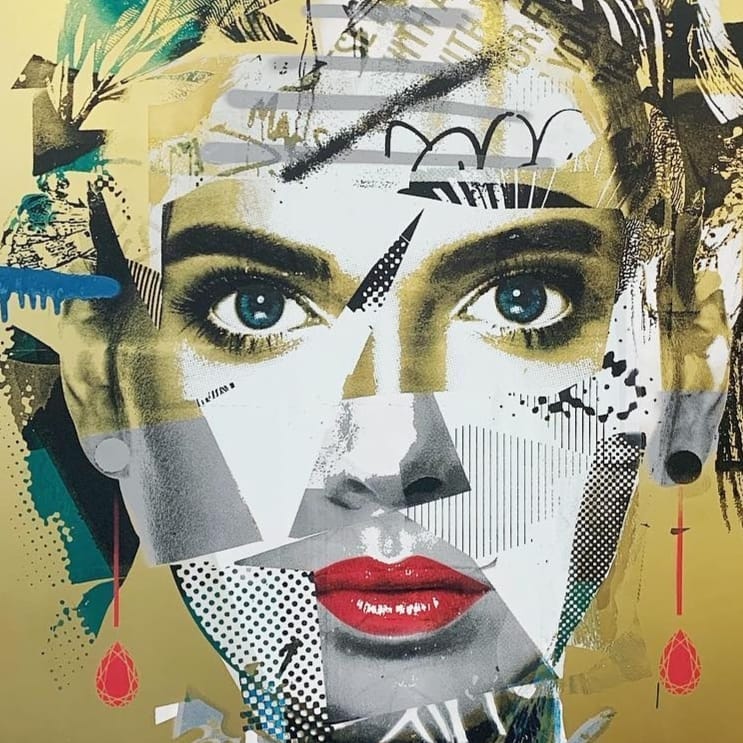
Often the text forms the title of your work, right?
Yeah.
With the typography of the text, are you playing around with that, or using the found visual? Is the text both a signifier as language and as a visual form?
I have always had a big interest in typography, especially in my commercial design work, but the text I use in my work is more often found than a decision to use a trendy, disposable typeface, or even one that is timeless, they are often a bit low-res…
That process of collation, putting all your ideas and images together; scanning, compiling, composing, is there an equal balance between that process and actually producing the work from that sketch?
Oh yeah, there is lots of preparation and planning, so probably sixty percent is that preparation, and forty percent is the application. But in saying that, a lot of the new processes I’m working with, the structures and layers, they are making it more like fifty/fifty…
Within the structures and layers of your compositions there is also a gestural and apparently free-form mark-making, which almost seems at odds with your design background, how open are you towards the end goal when you are making work? Do your sketches reveal how something will look, or can they change over the process?
The scanned image will pretty much be the final product, but in saying that, once I start, I might cut bits out. It is a pretty loose process but the actual appearance of the face, I’ve got the scale right, I’ve got the stencil size right, so that element will generally look like the sketch. Going into my street works, it is really helpful to be able to show a client how a piece will look. So, I guess my smaller works are similar to my larger works in terms of process.
I always remember Porta saying how he respects your ability to solve problems, that you handle things on the fly and find solutions. Is that something you take pride in? Having watched you paint, particularly outdoors, you are use a raft of techniques, from stencils to screen printing directly onto the wall, and in your studio, I imagine it’s even more diverse, because of the extra freedom that kind of space provides. Is a challenge a necessary part of the art-making process for you?
I was saying to someone the other day, I need a challenge, I’m always trying to push the boundaries. It is kind of why I got out of design, because I found I was just doing the same thing over and over. But at the same time, I guess the problem-solving element comes from my design background, where you are solving a problem for a client essentially; they have no collateral or visual presence and you are solving that for them. So, I suppose it comes from that. I guess I like to always explore ideas, and on a wall, you know you will learn something new every time. In my studio works as well, I will be like: ‘Next time I will be able to do that, because I can see where I want to be heading…’
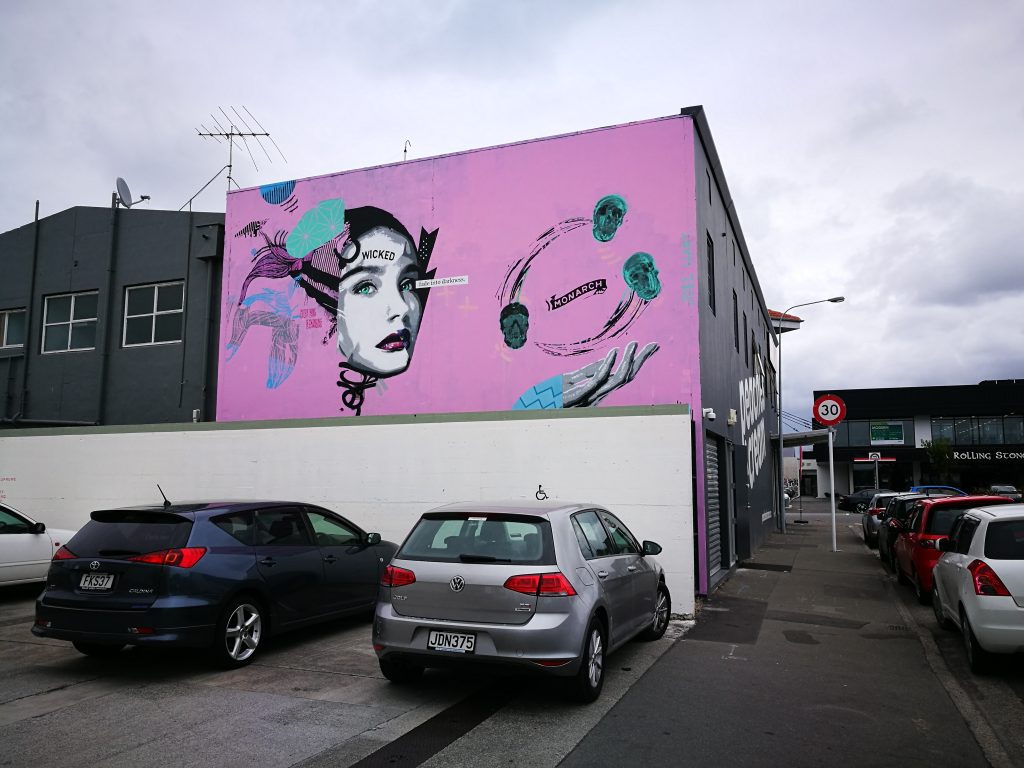
You can see a larger tapestry?
Yeah, like heading into some sculptural work is a massive learning curve for me, working with steel, with timber, engineering stuff…
Is that something you are leaning into yourself? Or do you have people helping you? A lot of artists will work with fabricators and technicians these days, but I feel like you are more hands on, that you would want to be on the tools…
I’m very hands on, but I have very limited knowledge in that area. So, I’m just learning different things, like welding, not that I’ve done much, or steel fabrication, getting ideas and asking questions to see if it is possible to do stuff. The work that comes from it will still be my style, I still want to work in layers, but I am interested in making things that can occupy public space…
Is there any work in Dopamine that represents that direction, or is it a longer-term goal?
It’s probably more of a longer-term goal, but I’ve got a couple of things I’m trying to pull together, so hopefully I can pull it off, but it’s only a couple of weeks away!
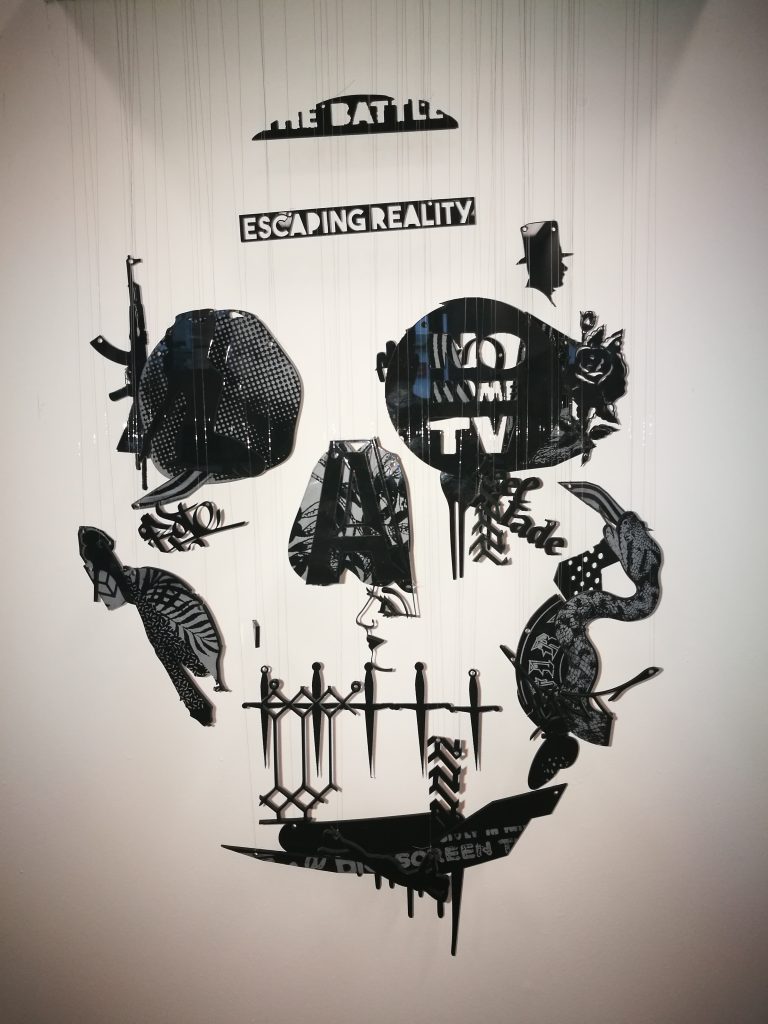
You have been working with layered plastic and copper sheets, what other materials have you been working with? What are you seeking from these different materials, especially as they become more and more important parts of your work?
Yeah, I’ve been playing around with iridescent lighting effects, with film, and mirrors, and just playing with how light can sit in a room. That’s something that has always interested me, spreading the layers out so I can work with shadows, exploring the angles of shadows and light, and how light reflects off surfaces. I’ve always been interested in repurposing things, ever since I was a kid, I loved finding stuff and making something. It’s experimental, playing with different things…
When you decide to use a copper surface or a mirror surface, how do you decide what type of image to use, and how do you develop the relationship between those two elements?
It sort of just comes naturally, because it just starts as a rough sketch and develops from there. I’ve got all this material in my studio that I think will work with something later, so if I know I’ve got a piece of mirror that’s six hundred by six hundred, I can sort of build my composition into that mirror. Often, I will just put something aside, like a rusty bit of steel, and once I start on piece, it will be like, oh that will be perfect for that…
Obviously, you enjoy the ability to experiment with these materials in the studio, but do you prefer that environment to working on a mural? Do they feed into each other, or is there a preference?
At the moment, I’ve been stuck in the studio, so I can’t wait to get outside on a wall. But then when you have been on a wall for a week, you can’t wait to get back to the studio! It’s quite nice to have that balance. And it’s good to have the design, not that I do much at the moment, but it is sometimes quite nice to do some of that, to have a more structured brief.
In terms of public, or street works, you aren’t from a street art background as such, but your work definitely has the urban contemporary aesthetic and obviously stencils form a massive part of your work. Have you ever had a desire to do smaller, intervention-style stuff? More post-graffiti street art, rather than the larger muralism?
I’ve always been interested in it, and being a stencil artist, you would have thought I would have had that background, but I don’t know, I was always inspired by graffiti, but I never really liked the idea of painting someone’s wall, I don’t know! But I love the history and I guess I just have always taken it more as a studio practice…
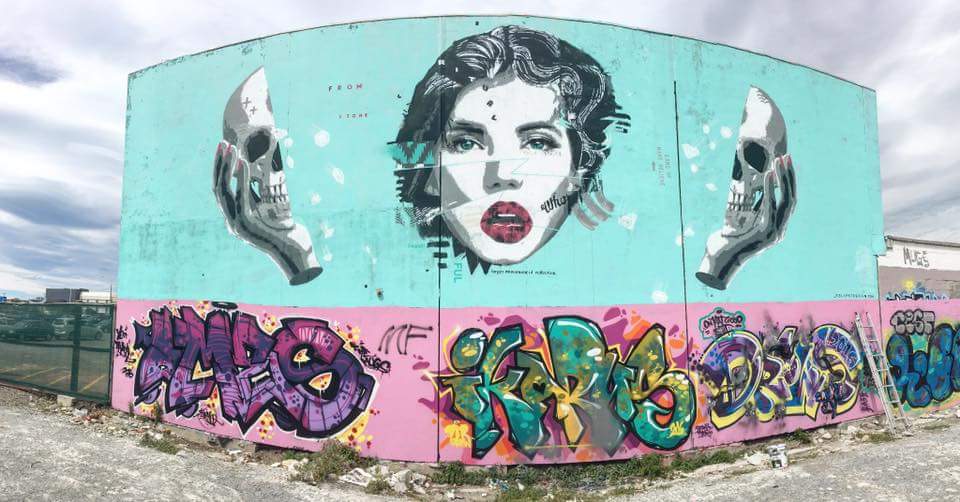
What was your introduction to stencilling? I always ask that, and there always seems to be a common entrance point, like making a stencil of some type of pop culture icon, and then progressing from there. What was your early influence? Was there a particular artist who influenced you? Which stencil artists do you look at now and respect?
I think I saw Rone’s early stencil stuff, it might have been in Wellington? At that stage I was studying graphic design, so I had the tools to make a stencil, and then all my work started to look like that, I used that aesthetic on every project. Then I started cutting and I always just used fashion magazines, because I had them around, and my Nana always had them, as a kid I remember she had stacks of them, so I would cut pictures out, female models in black and white, and I always liked that look for stencil stuff. Logan Hicks was a massive inspiration for me, the massive scale stuff and the process of learning how to break it down…
To break down an image and build it back up? That always fascinated me as well. Did you have those moments where the penny drops with your process and the whole image changes, it unlocks the potential of what you can do with a stencil?
Yeah, it’s amazing right? I got up to twelve-layer stencils at one stage, but I realised I only needed three or four, sometimes only two, I don’t need all those layers to get across what I’m trying to do. Logan Hicks used to do massive thirty-layer stencils, but he basically said you don’t need to do that…
I admire the approach of artists like Flox, Alice Pasquini or C215, where there are only one or two stencil layers, which serve as just like a defining marker over the top, while the gestural painting plays underneath to build the composition…
That’s sort of how I do my larger stuff. I have one stencil essentially and cut the black lines and the grey and white lines, all as one, so its all lines and then you are pretty much colouring in once you take the stencil away…
This all makes me think that your stencil work could be a really nice surprise if it was made on a smaller scale in the streets. The transition between street and studio shows that your work can scale up and down, so it is a real possibility…
It has always been in the back of my mind, I’ve just always been so busy with commissioned works and stuff, it’s just taken off, so I’ve been pushing that…
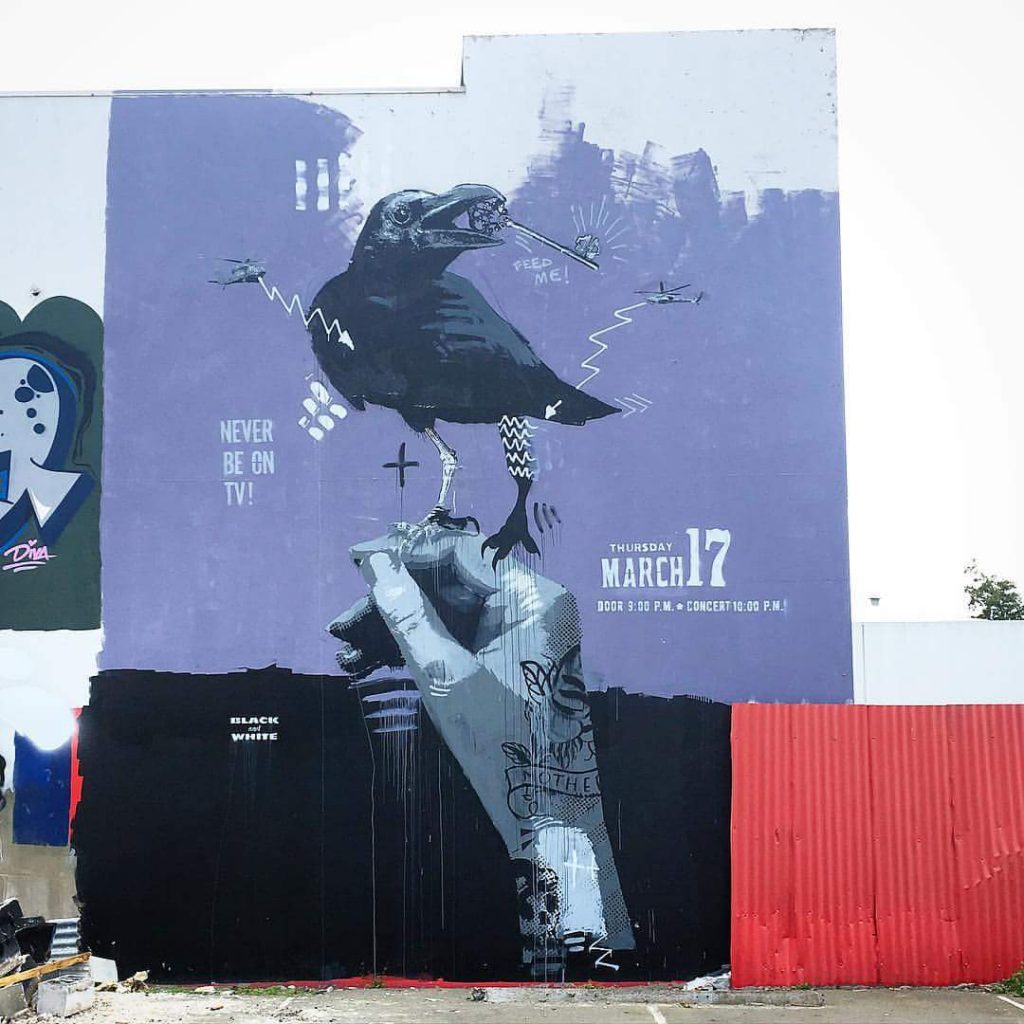
Your use of screen printing, has that been influenced by stencilling, or has it influenced your stencil technique? Do you delineate between the two? Because they form big parts of both your public and studio work…
A screen print is just a stencil essentially, just a different application, pushing the ink through instead of spraying it. But I worked as a graphic designer for a screen print company for a while, so I got the basics of splitting my image, then breaking down that image further for t-shirts and stuff. I didn’t really think about using it in my art work until later on, when my wrist was killing me from cutting stencils, so it just came from a negative really. It has become a main feature of my work, the main detail is in the screen print and I will then stencil behind it, if that makes sense. I also use kind of a grungy approach to make a screen, I wouldn’t use it commercially, like some bits wash out when you are trying to hold it, it’s quite a back-yard process…
As a stencil artist, do you have that feeling of inadequacy around can control?
I’ve always used stencils and relied on stencils, so I’ve tried a little bit but I’m not very good with a spray can. You watch people do it, like Wongi and Yikes, and it’s like, how they can do that! In my past I would do pencil or charcoal drawings, so I’ve got that drawing background, but it’s just another thing, even with a stencil sometimes, it’s hard to get the effect you want…
With your use of digital approaches, how much do you find that you draw in the ‘old-fashioned’ way now? Do you try and keep that habit up or have you found it less necessary?
I used to do it lots, just because that’s where it started for me. But even with my sketches, you can hardly tell what they are now, they are just quick scribbles. I would like to bring it in more, it would be like going in a circle, because the roots of what I do come from drawing, I used to do pictures of people’s dogs and kids, they would commission me to do that, and that’s where it started. I worked for an architect as well, way back, drawing renders of houses and stuff, so it has all come from that…
It has always been there?
Yeah, but I’ve found other ways to do it, I don’t know, I guess it comes from that experimental approach of every time I do something, I try something new, and it has been replaced. I always have my tablet, and I always draw, but it is straight onto the screen, I guess it’s the way it is going….
How did the show at Fiksate come about?
It is exciting for Fiksate to be in town now. It is really cool to see where it started and where it is heading, it feels like a big step up. It’s a really cool space and I really like what all the guys are doing there. They are also really nice people to deal with, and I guess that’s the main reason. It fits my work perfectly too, as an urban contemporary space.
As a specialised space, it must be helpful to not have to compromise, or to have to put extra work into finding and transforming a space. How does the experience with Fiksate relate to previous experiences?
My original thought for this show was to have a big warehouse, and to run it all by myself, but working with Fiksate, I can focus on the art and not the space and the marketing, they are taking care of that. I think Yikes said the same, it’s nice to focus on the art for a change, because there is a lot more that you don’t think about behind the scenes…
All the little stuff, right? A lot of urban artists are using alternative spaces, like DSide and Extincted, where he made a fake gallery, or the Underbelly Project in the subway tunnels of New York, or Hanksy’s (now known as Adam Lucas) take-over of an empty Los Angeles mansion, was that your thinking around a warehouse space?
Yeah, absolutely, you always want to push your work and display it places that blur that line between inside and outside worlds…
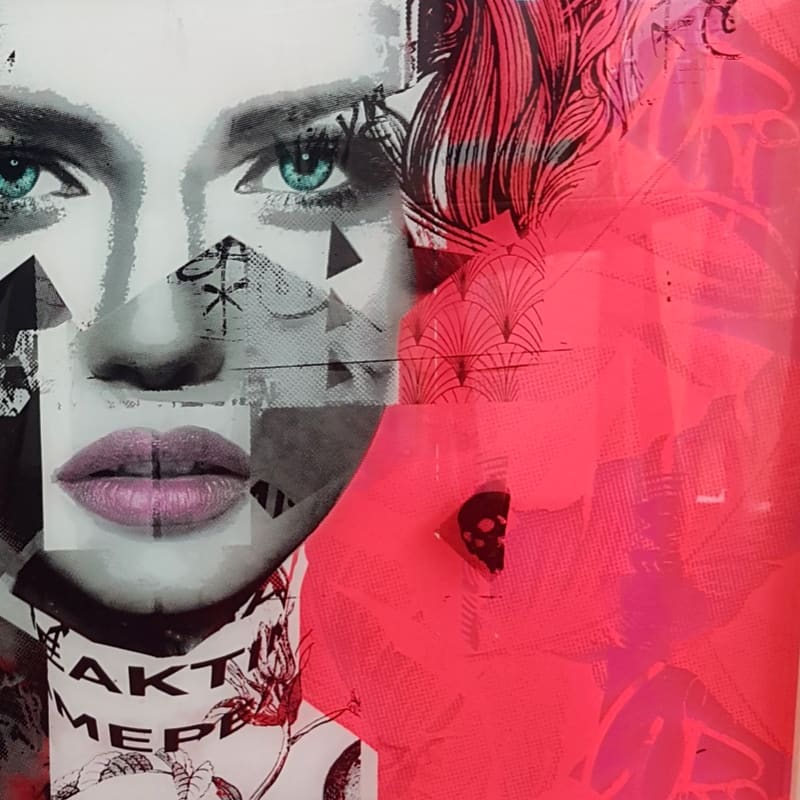
Blurring that distinction between gallery and urban spaces?
Yeah, for me, I really want to show how I can tie together all the elements of my work, the outside works, the studio works, the sculptural elements that I am really interested in. Like, how Vhils makes the image out of the wall, that really interests me…
The idea of urban excavation…
Using what is there and building on that…
The last few years have been pretty crazy for you, right? Your work was included in the Australian Stencil Art Prize touring exhibition, and despite not being at all comfortable, you were featured on a reality television show, what has been the most unexpected thing to happen over the last few years?
Being on The Block! I hated it, aye! I was so nervous! I hate the idea of it, but I like pushing myself outside of my comfort zone because if I don’t, I don’t feel like I’m going anywhere. So, it was a good way to meet people and push my brand out there…
It is important to help grow your profile, but a show like Dopamine will ultimately be more important in terms of your artistic development, a cohesive body of work is a more important proposition than just putting your name out there, right?
I suppose so, yeah. Like we were saying before, pulling together all these ideas I have and trying to show them in one body of work, and, as opposed to sending bits out, or working on this project for this show, it’s different. It has consumed me for a few months, it is all I have been doing…
I assume you can see the light at the end of the tunnel now, and for someone like you, are you straight into the next thing, or do you take a step back and relax?
Nah, I’m onto the next thing. I’m always thinking of what I’m going to do next. I’ve got a couple of murals to do and commissions to work on, and of course I will be trying to develop the sculptural stuff…
What sort of experience have you had working outside of Christchurch? Do you see that as an inevitable and exciting pathway?
I haven’t done that many street works outside of Christchurch and I would like to, just to get out and see more of New Zealand. I would like to do that more, so it’s been a goal of mine to make contacts over the last six months. I am also looking at maybe Australia, and approaching a few galleries there to do some stuff…
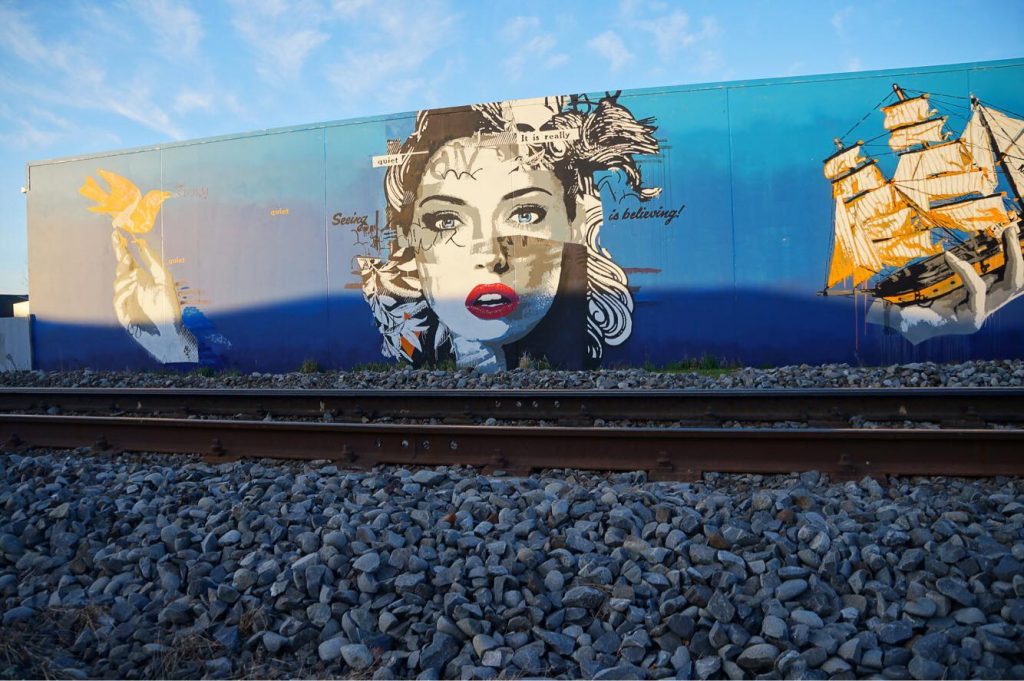
Have you looked at the festival circuits? There seems to be a new event every month, and in increasingly surprising places, so it seems like it could become a more viable option, right? With the likes of Street Prints, Sea Walls, and various other independent events, you could potentially be all over the country…
I haven’t been a part of them, but I would like to, I just haven’t had the opportunity yet. I haven’t really pushed it though, so if it comes it comes about, I will just say yes to everything, although that’s how I ended up on The Block!
I guess it could’ve been worse, it could have been Married at First Sight, right?
That’s addictive bro!
I can’t say I’ve exposed myself to that addiction yet! I’m fascinated by the different backgrounds of people, and part of your story is your time as a basketball player. Do you see any overlap between playing high level sport and making art? I know a lot of people might not see that connection, in fact they are often set up against each other, but I’ve always had a relationship with sport as well, and I’ve always thought about the aesthetics of sport. Basketball in particular has that mixture, with the branding and the visual identity, but then as well, the physical performative element of sport and the repeated perfection you search for, searching for your stroke when shooting, your handles of the ball, did you ever think about the connection between the two? I know you kind of moved between the two rather than occupying both, but do you see that connection?
Yeah, I definitely do, I always think about how I got to where I am as an artist, and my former career as a basketball player. I have always had an addictive personality, and if I do something, I want to do it as best I can. I did that with my basketball, and you end up training three times a day, it consumed me. I loved it, it was all I did. But then I don’t know, I stopped, I had kids. Whenever I was on basketball trips I was always drawing. I never had a style, but I was always drawing cartoons and typography, and then as soon as my basketball stopped, my art career took off. I always had my design background, or trade I suppose, and then I put all that hard work, that training mentality I took from basketball and I applied it to my art making, and I just didn’t stop doing it. I wanted to learn new techniques and master them, just like you perfect your skills in sport. Like you said, the aesthetic side all links together as well, the branding and design work and the aesthetic side of sport all work together.
Speaking of that visual branding in basketball, do you a team that you really like their branding and visual culture?
I like the Golden State Warriors and how the logos went from being eighties-styled to being really colourful, back to being really simplistic. As a kid I used to draw all the logos and laminate them and stick them on my wall…
I did that as well!
I suppose that’s the process, the aesthetic side of it. I like the singlets as well, the design of singlets, how they have gone back to really simple concepts, with bold colours…
To finish, what can people expect from Dopamine?
I can’t compare it to my last show, but I kind of see this show as a big progression from that show. My finishes are different, it’s just a lot different really. It’s more experimental I suppose, I see it as a stepping stone for me to show some of the stuff I want to be doing. There are quite big pieces that I have been working on, and a few more prints. I’ve only done one print before, so there will be a few more prints…
Prints are accessible, which is why urban artists have embraced them. Have you worked with a printer to get the standard you want? I imagine it is really important to get the right image quality and replication, especially since you have such an interest in surface textures and finishes. Was it easier because of the digital rendering process?
I kind of mix them together a little bit. The prints are a bit of digital and screen print, so there is that tactile feel. That’s something that interests me as well, from that design perspective, the combination of the digital and the real. So, it should be quite interesting, no one print will be the same…
I’m sure they will be popular! Thanks Joel, good luck for the show!
Cheers!
Dopamine opens 5:00pm on Friday, March 15th, at Fiksate Gallery, 165 Gloucester Street, running until April 25th.
Porta – A Helping Hand
A few years ago, I would have said Porta was one of Christchurch’s best kept secrets. But to make such a claim now would be misleading, his street and studio work continue to gain exposure and opportunities to work with an array of amazing talent and in a variety of contexts. Having known Porta for a good while, it is refreshing to be able to say that such reward is justifiable evidence that good things happen to good people. With his infectious energy, he constantly reminds me that getting ‘amped’ on things, as he would say, is a vital ingredient in enjoying what you do.
His array of images, heavily drawing on pop culture and his magpie-like inquisitiveness, have a strong street style, but also a sophistication that has developed with his sustained practice. Primarily a stencil artist, Porta’s work ranges from walls to found objects, such as skateboard decks, reclaimed thrift store paintings, street signs and even randomly recovered pieces of wood and metal, and even extends to large MDF cut-outs and, of course stickers. His images increasingly juxtapose pop culture references with abstract designs, distressed surfaces, or revealing indications of the aerosol medium. These playful qualities ensure his work is both accessible and attractive, easily shifting between locations, while still seeming authentic in approach. I sat down with Porta at his shared studio space Fiksate Studio and Gallery in New Brighton, and we reflected on the various projects and adventures he has experienced over the last several years, his take on his own practice and why ‘liking people’ is always a good starting block…
Although you never admit it, the last several months, actually, several years, have been pretty busy for you! Recently you assisted Dcypher and Oi YOU! with their project at the Christchurch Airport, and a few weeks prior you helped Flox with her Plymouth Lane mural in the central city. You have worked with Oi YOU! quite a bit, so there is a relationship there, but how did the opportunity to work with Flox come about? And what did you make of the experience?
I basically just put up my hand to help out where I could, if she needed it. So, I ended up buffing out big squares of colour for her and filling in some of the letters, so she could stencil over the top. I was mostly on the brush and roller…
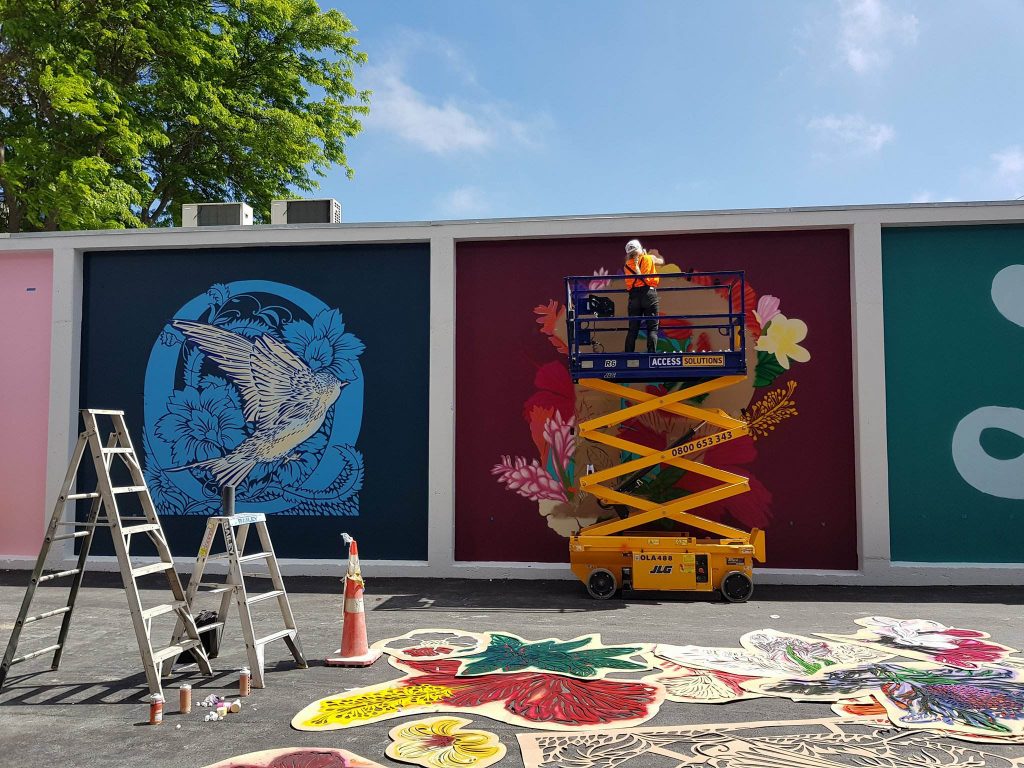
As a painter by trade, you have a practical versatility to be able to do different kinds of things and help people in different ways, and that’s given you many opportunities to work with artists on an array of projects, as well as influencing your own work. Did you always see those skills as transferrable, that they would open some doors?
Yeah, I feel like still like I’m more skilled behind a brush and roller than I am with a can, any day! (Laughs)
On the flip side, as a stencil artist, did you take the chance to step back and observe Flox’s techniques and learn from her?
I did, and she is really open when chatting about her processes, like just about the stuff she uses to cut her stencils from, and that sort of thing. She’s really open about it all, which is really cool, because sometimes, you can understand why someone might want to keep it to themselves…
I kind of feel like with stencilling there is a mystique about the process sometimes, but when you can pick up little things, you can take them in different directions. For instance, seeing such a large-scale stencil piece being produced must have been a valuable experience for you…
Yeah! The size of that work blew me away. Seeing a stencil being produced at that scale was really impressive, and seeing that it was actually do-able, it was crazy!
Speaking more broadly, not just from the ‘handy on a roller’ perspective, you have a real willingness to offer a hand wherever needed. As a result, you have worked with a wide array of people. Is that attitude just a reflection of your approach to life? Or is it that you see opportunities when they come up?
It’s important to me, I like people, so that’s a good start. From there, I really like street art and I want to see it do well in Christchurch, so it’s a combination of those two things really.
It has been a pretty amazing few years in the city, and in many ways, you’ve been right in the thick of it. Amongst a raft of well-publicised events, there has been the growth of your own ‘baby’, CAP’D, which has now been staged three times. You conceived of CAP’D a few years ago, so what was the initial idea, how has it evolved, and where do you see it going?
I asked people if they would be keen on a show of local artists who worked on the streets or were influenced by that scene. I put it to a few people, ‘what do you think if I did this…?’, and everyone I mentioned it to was just super enthusiastic and receptive to it. I had friends who wanted to be involved and put art in it. So, next thing, it really took off and it was just, ‘well, I guess I’m doing this…’ Which was a cool way to do it because it got me motivated, and the next thing I knew, I had sorted dates, found a place, and people were just so enthusiastic that there was no way I could back down!
I remember when you first started putting it together, it was originally a much smaller idea, but by the time the opening came around, it had grown into something quite different…
The support was amazing, it was meant to be this small, chilled out thing, but it ended up featuring artists from overseas, not just local artists. On the night, it was quite overwhelming, the amount of people who turned up, the amount of art that was there… Which is why for the events after that I had a wee crew of people, with Jen (Jenna-Lynn Brown), Dr Suits (Nathan Ingram) and yourself. It was definitely a team effort after that, which was a relief! (laughs)
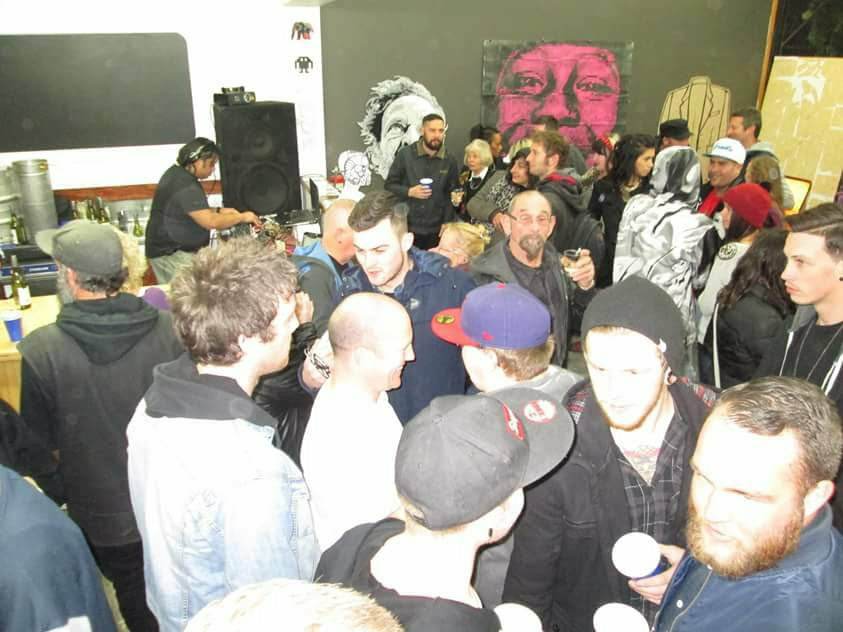
I think it showed how Christchurch has an audience that wants to see this kind of art, and these kinds of events, but also it revealed how you can connect with people from overseas, and that those networks are closer than we ever thought. Over the last several years CAP’D has featured artists from Sydney, Barcelona, Japan, Los Angeles and more, but even in the first show, there was work by artists from Melbourne and Brazil, so it kind of set the precedent…
Yeah, that just kind of happened…
It showed you can approach artists from the other side of the world and say: ‘Hey do you want to be part of something?’ and often the response is ‘Yeah!’ Were the positive responses a surprise to you?
It was, because not long before CAP’D, I’d just sort of got into Instagram, and I realised how approachable everyone was, people I considered quite well known, I didn’t expect them to respond to comments but they did, and then I thought, I’ve pushed my luck already, I should ask them if they are keen on being in an exhibition and a lot of them surprised me…
Which must be a good feeling, because that old saying ‘never meet your heroes’, isn’t always true…
Nah, sometimes it’s great to meet your heroes!
So, where do you see CAP’D going? It is now hosted at Fiksate [Design Studio and Gallery in New Brighton], and it has evolved slightly over the last few years, do you think it’s going to keep growing or are you happy for it to keep to a specific scale?
Yeah, I like the size of it. It wasn’t ever anything that was supposed to get bigger and bigger. It was supposed to be pretty small, so now it is the size that it is, and I just want to sort of keep it here, keep promoting new people, new talent, and putting them alongside talent from around New Zealand and the world…
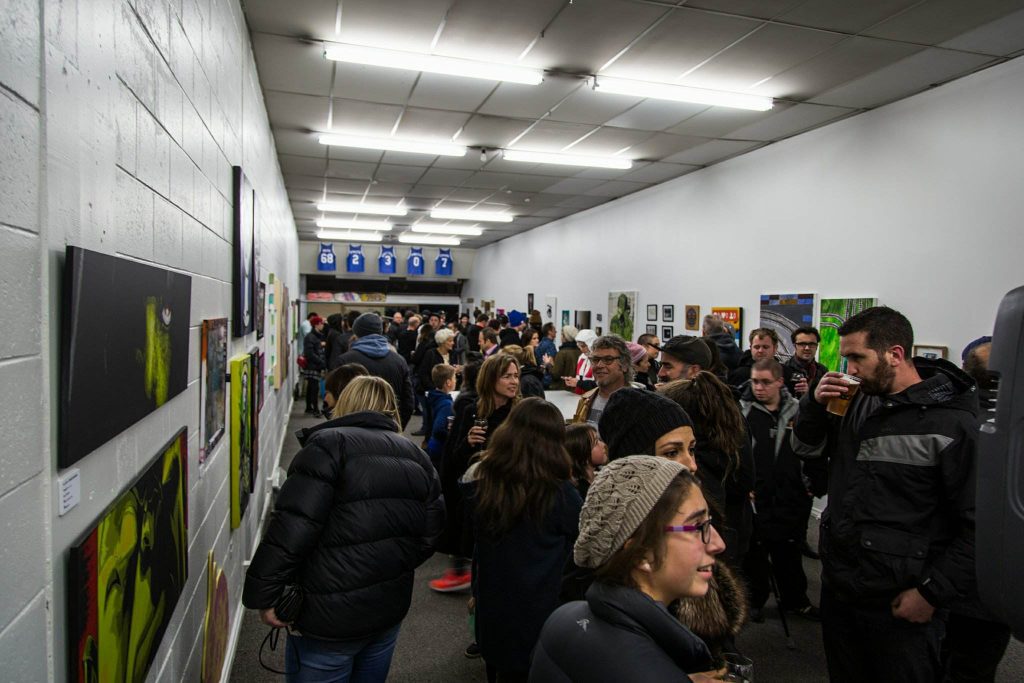
That’s the really important part, right? It’s giving a forum for young artists, lesser known artists, artists who come from particular backgrounds, where finding ways to exhibit works can be a real challenge…
Because a lot of these artists are not new artists, it’s just the first time they’ve put their art in this particular kind of environment…
Most of them have been drawing, writing, painting, making in the streets, or some of them in their bedrooms without putting anything out there, and it’s just a case of creating this new forum, so there’s real value there, and it’s partly the response of the artists that reflects that, they appreciate that you’ve created something that gives them the opportunity, so it must feel really good! (Laughs)
It does, it really does.
Talking about CAP’D’s evolution brings up another big development in your artistic life; setting up Fiksate with Dr Suits and Jen. That seems to have provided you with a real stimulus. How did it come about?
So again, I was just yarning with Nath and Jen, and saying I’d be keen on opening a spot, and then we made some connections with people who could make it happen, and all of a sudden, that momentum had picked up, and we had our spot. We did check out a couple of other places around New Brighton, but in hindsight I’m glad they didn’t work out, because our spot seems pretty perfect really…
Do you find being in that collaborative environment has expanded your practice? Does the shared, dedicated setting make it easier to explore ideas than if you were at home in the garage?
Well, I do, but sometimes I think I almost get an equal amount of satisfaction when I’ve been able to help someone get to where they want to be, rather than if I was getting myself somewhere. I think that’s why a lot of the time people want to get together with me, because they know I try to be a willing helper…
When I have been around Fiksate, there is a real feeling of coming together and problem solving, offering advice and feedback. Even when it’s not you making something yourself, that experience of thinking about somebody else’s work can be just as beneficial in the long run… Working with Jen and Nath, who both have quite diverse practices, has watching their different material approaches influenced your stencil making technique?
Yeah, (laughing), and it’s made me do things in a way I didn’t think about and to go in directions I didn’t think I would go. Like, Nath will just be buzzing on something I’m doing, and then I’ll be buzzing off something he’s doing, and then when we are all finished, whatever we have made will usually have a few similarities (laughs) and not on purpose, but we just realise we are both being so inspired by what is happening in the studio that it comes out in our work… Like with the piece I did for Blind Date, which was an exhibition for First Thursdays last year, and probably the series of Donald Duck works that came from that, I think they came together in that way, even though the piece was a colab with another artist, Kara Burrows, we kind of worked separately, and it was at the studio that my part really came together. I feel like Nath had a bunch to do with that, and you were there that night too… I was trying something new and you guys were getting really hyped off the stuff I was doing, and I think that excitement came out in the work, so yeah, I think that is what it’s all about, just getting each other really hyped on the new stuff you’re doing and then you want to do heaps of it and take it further…
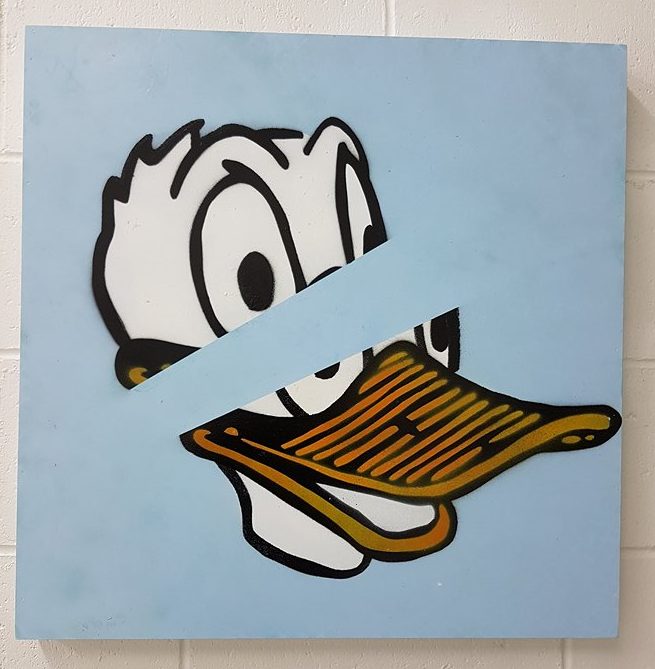
Tell me about the development of your stencil style over time, because, to me, your stencils, despite their diverse nature, from the actual images to the material surfaces you use, they always seem to reflect a street vibe, how did you get started?
I think I had been influenced by a stencil I saw in town, on Manchester Street years ago, like in the mid to late nineties, so I tried to make a stencil, I was listening to a bunch of Foo Fighters, and I tried to make a Dave Grohl stencil and I ended up with a bunch of shredded cardboard that didn’t stay together and I just hiffed it away! Then I sort of revisited it, it must have been four of five years later…
It seems like everyone’s first attempt is always some pop culture icon, a musician or an actor… Do you think it has something to do with the medium? Does the technique encourage you to try and produce something realistic, and then we are just drawn in by pop culture through the image saturation of celebrities? Maybe it’s just the association of that type of imagery with street art’s vocabulary and traditions, that immediately recognisable image to grab someone’s attention…
That’s funny when I think about it, I don’t know why that would be, but it does seem true, they are probably the things that are making an impact on your life at the time. Thinking about those early stencils, I used to make stencils from the outside cover of an exercise book from school, and you just sort of made do. I think I had a huckery old craft knife. I think the drawing I did of Dave Grohl, I was pretty amped on it, and then I just tried to make it into a stencil and I couldn’t quite pull it together!
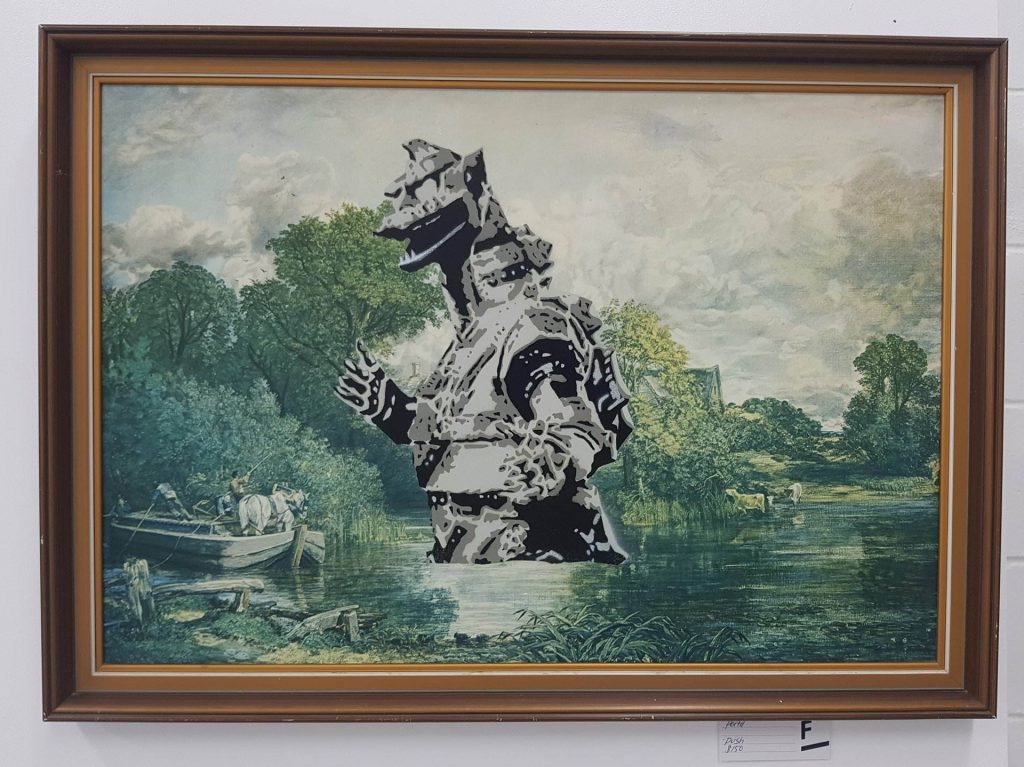
It’s a technique where there is value in just trying and failing, and then starting again. I think there is also a lack of pretense as well, I mean using the cover of an exercise book, using a cereal box, like that approach is entirely fitting, and even now, you’ll know, you have a preferred method to use to cut stencils, but it varies wildly, different people use different things and it’s all about the way they’ve developed their techniques. So, then you picked it back up after murdering Dave…
Maybe four years ago? Maybe more, I can’t pin-point it. I know the next one I did was based on a sketch of R2D2 [the droid from Star Wars] that I’d done, it’s on the rubbish bin at home, that’s the only place it ever went, but I think from there I started messing round with the technique more and more…
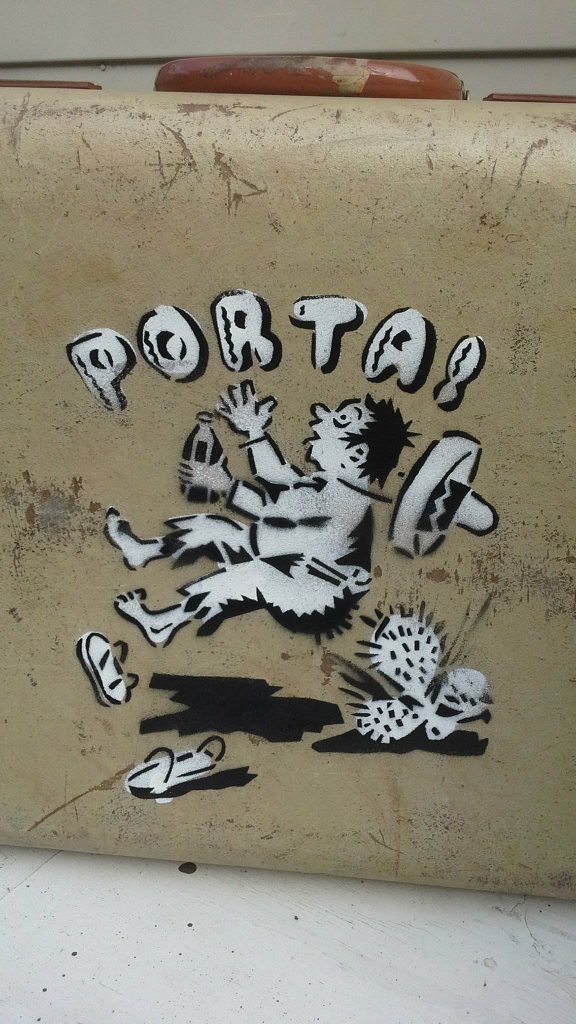
Who were your influences? Who, or what made you think, ‘Yeah, stencils are for me…’?
Of course, Banksy would have been an influence and I think he’s great. I liked that he was doing things I didn’t expect. I mean everyone likes to be surprised, and when I saw what he was doing, it made me want to try different things. But there were other people too. I like a Mexican artist called Acamonchi. I like his punk style, I was never into punk so much, but his style and that aesthetic just appealed to me, it was gritty and dirty and cheeky, the images were sort of taking a whole heap of ideas and layering them up in a messy way, just making really interesting mash-ups that came together super well, in a really free sort of way.
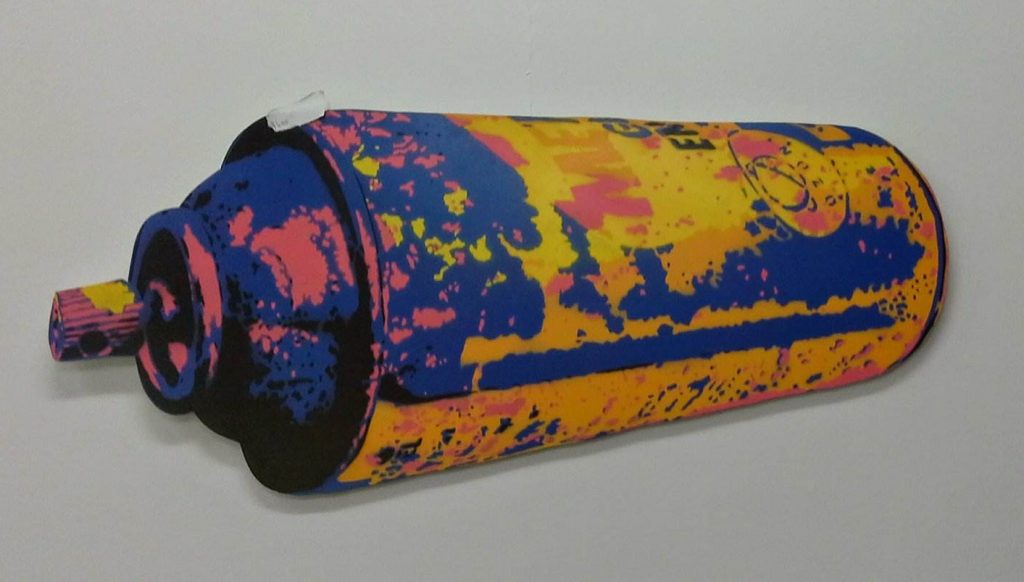
Even though graffiti is so strongly entwined with hip hop, for the wider street art culture, or post-graffiti, and I guess some graffiti writers, punk is a really significant influence, in visual style, material forms, like the influence of band fliers and posters, and of course the anarchic, DIY attitude…
Yeah, there is definitely a strong punk influence in the history of stencilling, it’s an unavoidable influence.
Did you primarily see stencilling as a street technique, or did you also perceive it as something that could transfer from wall to canvas, so to speak?
When I started I just wanted it to be on the street, I didn’t ever want to stencil on something you could keep. But then over time, I started appreciating the time you could spend on a stencil, that you could layer them up. Then I started wanting them to, you know, stick around a bit longer, and just look at them and see what I was going to do with my next one, stuff like that…
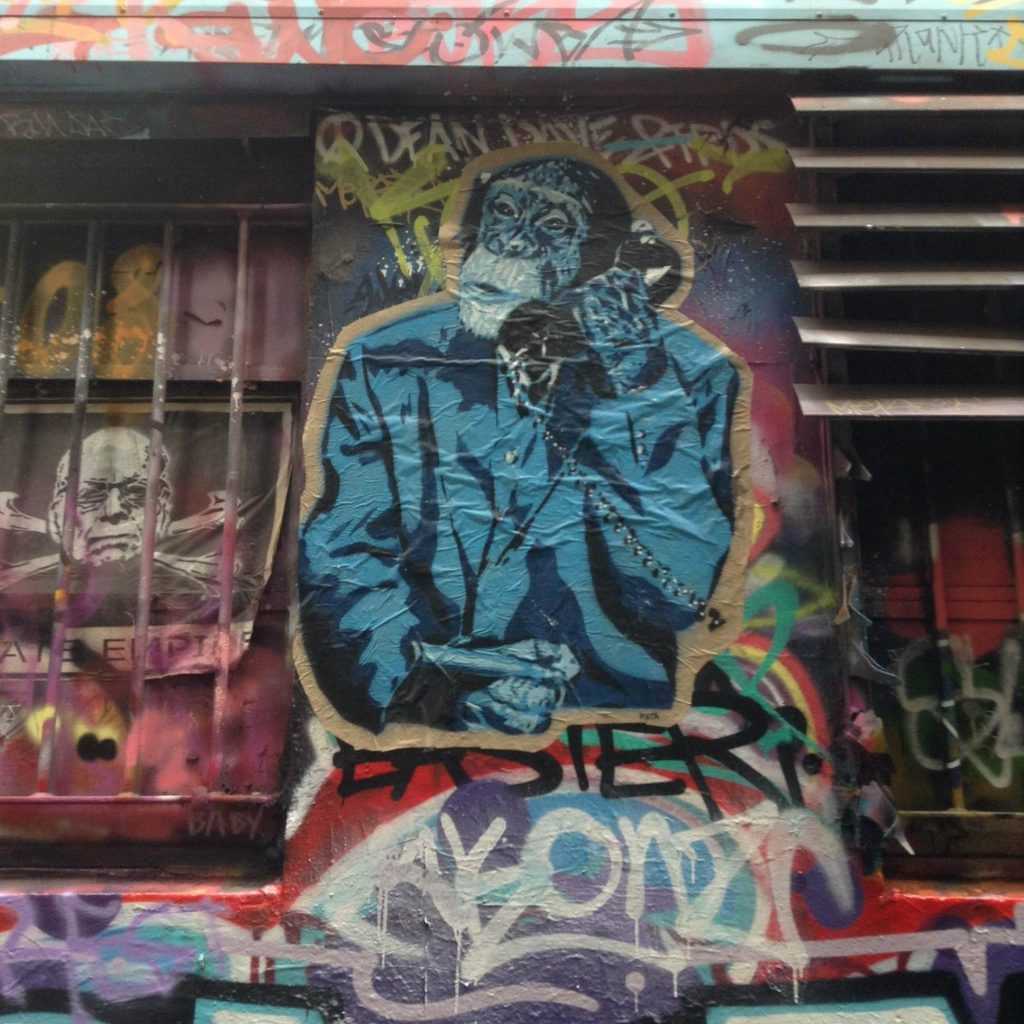
Now you work on a whole range of different surfaces and objects, but in many ways, they retain a sense of street work, at least in their visual style. While stencils are your primary method, your other love is stickers and slaps…
Yeah, definitely!
You have made thousands of stickers; hand-drawn, stencilled, you have even used block printing techniques, when did you start to making stickers? Did that come after starting to cut stencils?
That would’ve come before. I was always trying to draw stuff and I think one of the guys who influenced the sticker side of things for me was definitely [Christchurch artist] Xpres. He’s always been a real sticker guy, he’s always collected them, always made them, always putting them up around the streets, always with really nice hand styles. Eventually I found out the sticker culture was big in America. I was on the internet all the time trying to find out more, and I discovered a magazine called Peel Magazine, that I couldn’t actually get in New Zealand, but I could find stuff about it online, and so I just got real obsessed with that for a bit. I also came across a guy called Chris RWK, doing these designs called Robots Will Kill, and I just thought what he was doing was so cool, and the more I looked into it, the more I liked it. I think stickers, even though I do stencils, stickers will always be my favourite…
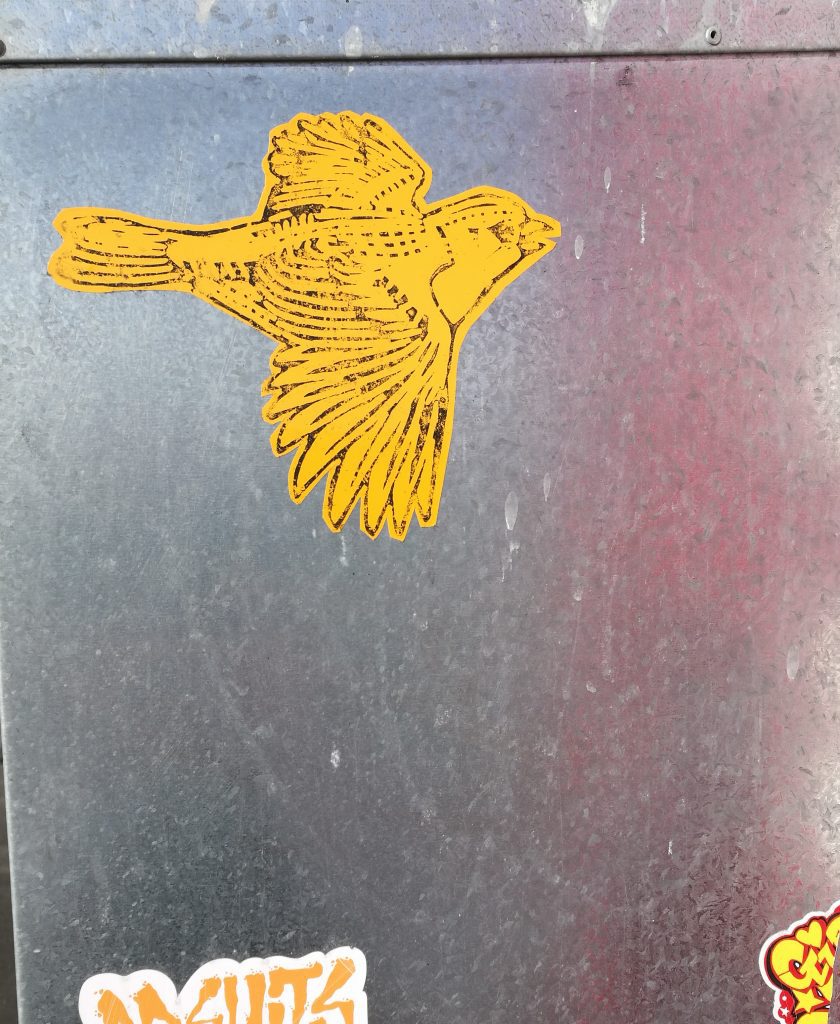
Speaking of stickers and Xpres, we were lucky enough to be involved with the ‘Stick ‘Em Up’ room for the first Spectrum show at the YMCA in 2014, and I remember how deep you got into the concept there, which was built on the idea of social media networks and dissemination, which was how we collected so many stickers from all over the world. You were just hounding people for stickers! What are your memories of that whole experience?
Again, I think it was before Facebook and Instagram worked the way they do now, because they play with the algorithms and stuff, but at the time, when people put stuff up, you saw it right away, and so we were messaging all these sticker artists we stumbled across, I was getting in touch with them, telling them about this event and trying to get them interested by name dropping people who were going to be in the show. And so many people, like eight out of ten people, were keen to be in it and then two would be like: ‘This some sort of scam and you just want to get some free art off me!’ (Laughs) Which I understand!
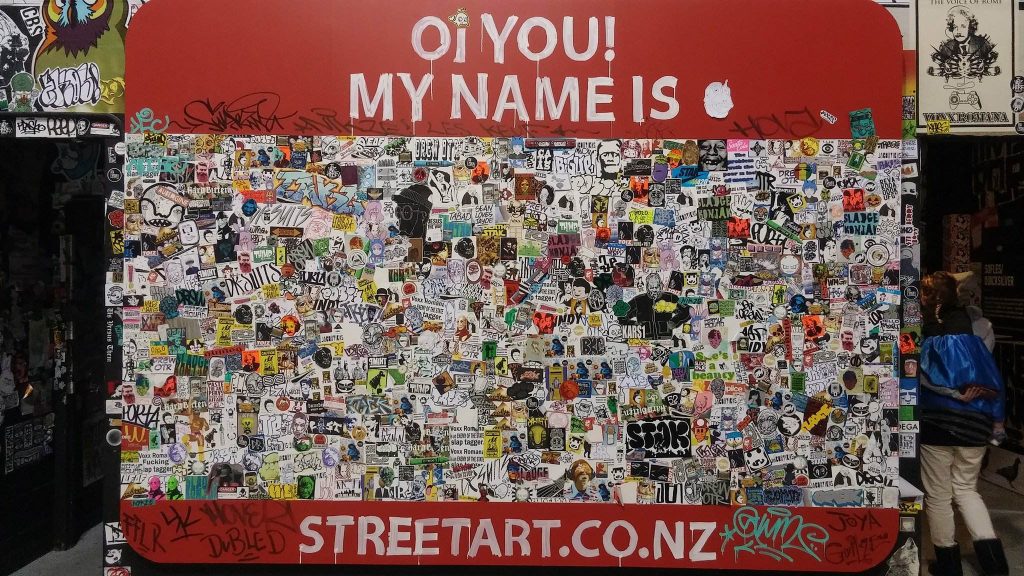
Yeah, it is understandable because of the nature of social media interaction, but it also shows that if don’t ask, you’ll never know…
Exactly, I remember, I had this book and I had written down, I think there was close to 800 people that I had contacted! Some people didn’t get back to me, but I remember thinking: ‘Man, it would be a crack up if on the day we are able to start the room, we had a big sack of stickers’, and I didn’t see it happening, but that was exactly what happened, like exactly! With that project, the other thing that sticks out was the whole team thing as well. It was Xpres, Nathan, Jen, yourself, and me, and I think it was such a cool team and we were all getting amped, everyday when something new turned up in the post we were just so excited, I’ve never been so amped!
For me, the temporary nature of that project was really cool, the fact that it is no longer there, that you can’t go and see it anymore, it’s an experience that was so ephemeral, and yet completely consumed our little team for so long, and we were so involved in the evolution of that space…
It’s like, was it even real? (Laughs) I walked around the room and made a video and I sometimes have a look at that. It was pretty cool…
You have been exhibiting more and more over the last few years, with CAP’D, at Fiksate, First Thursdays, and recently in some shows at the Welder Collective, are you more comfortable about making work to exhibit, or is it still something you are coming to terms with?
I don’t know if I’ll ever be super comfortable with it, but yeah, I’m more comfortable with it than I was at the start. But I’m a chronic procrastinator as well, so I’m always doing stuff down to the line and luckily a lot of the people I’m working with know me well and are quite patient (laughs), which I appreciate, because I know I always cut it fine! I don’t know why, it’s like if there’s no urgency, there’s no priority. But, I did always say, right from the start, if I ever felt like I was being pressured with this stuff and it wasn’t fun, I would stop. I do wonder if I get a buzz off doing stuff at the last minute…
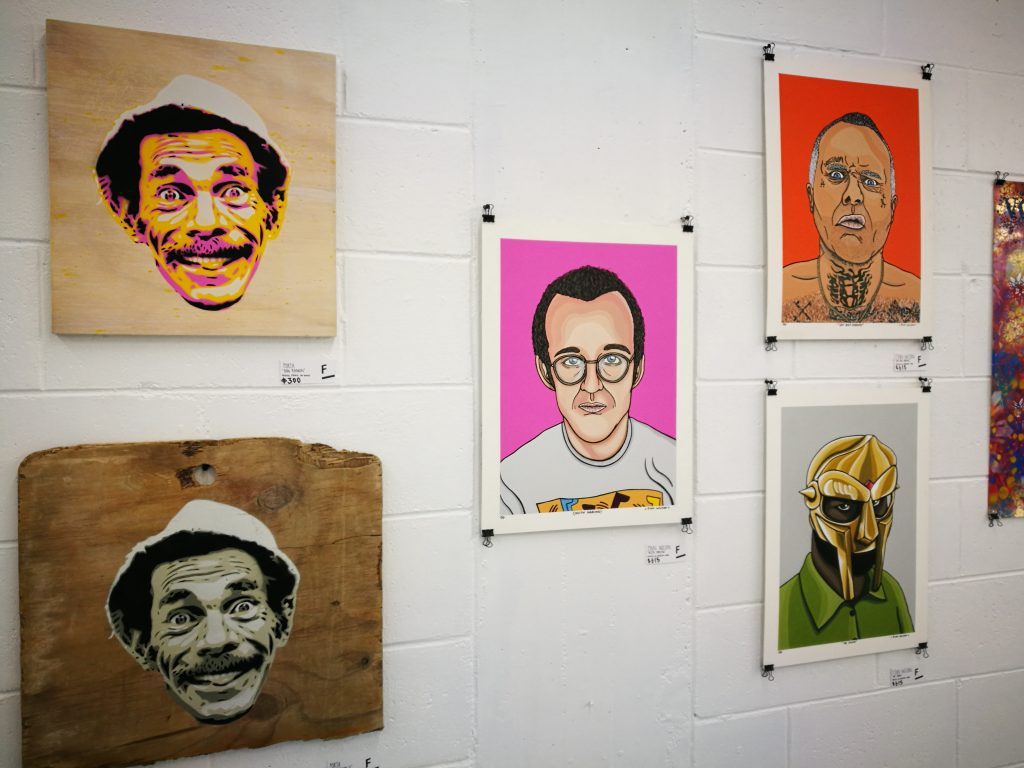
You need the adrenaline?
That could be it, I don’t know, I’m just sort of thinking that i always seems to end up that way!
As well as exhibiting more often, and helping other artists, you have been doing some of your own public work, probably the most noticeable larger public piece you did was the First Thursdays billboard on Colombo Street in 2016. Do you want to do more outdoor legal commissions, or you would rather make smaller stencils and make stickers?
I think that smaller stuff is really my style, but after working with Flox and seeing how she made that larger scale stuff look really fun, I think it would be cool to revisit it. That panel I did for First Thursdays was a bit of a nightmare, it was a bit of learning curve. The stuff I made my stencil out of was too light, and as I went to hang it up the wind came up. I was so stressed out, I didn’t enjoy it so much. I was so relieved when it was all over, which has made me not really want to do that size again, but then again, working with Flox, she made it look like something that can be quite manageable, and that makes it attractive again.
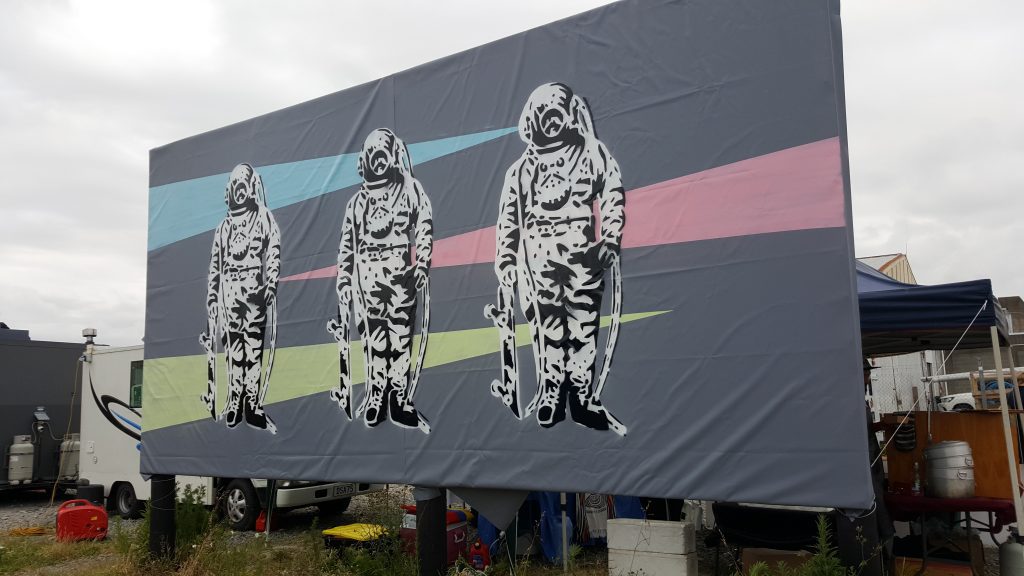
Making large scale stencils does bring a whole heap of challenges, especially when working in a public space. I guess often it comes down to compartmentalising the process, and that relates back to the stencil process itself: when you make a stencil, you cut layers and build those layers, so in making a larger scale work, it’s sort of the same principle, in that if you make those layers manageable, and build it piece by piece, you can take away some of the problems…
The other person who is great to work with and watch as far as doing large scale stuff, is Joel Hart, just seeing how, I don’t want to say he cuts corners, but I’ll feel like there is a way to do it and he’ll go: ‘Nah, there’s an easier way’, and he’ll just think outside the box and think of something different, and it’s amazing, it’s so cool to watch.
Speaking of local artists, who are you excited about? Who do you always keep an eye out for in the streets?
I am really interested to see what Kill is going to do next. I enjoy him because I never can predict what he is going to do. I sort of feel like maybe he is drifting towards doing more music, but that dude never fails to surprise you, which is great. I remember the first time I ever met Joel Hart, looking back, I was doing a market with these budget as, horrible stencils and he wandered up and his little girl was with him and we just got talking and he said he liked stencils, he didn’t say anything else and I was like would your girl like one of these, and I just gave it to her, and now I wish I had given him a better one! (Laughs) But from there, he took off with his stencils and got all famous and stuff! (Laughs) But it’s funny how things work out. I love seeing his stuff, I get amped seeing his work…
A few months ago, you helped Dr Suits with his piece for the Carnaby Lane event in New Brighton, which Joel was also part of, it looked like a fun day…
It was great! That was so much fun. I had so much fun with that. It was originally supposed to be a collaboration, but just the way things went, we ended up working with one of Nathan’s designs. So, I ended up helping him more than putting my own design up, but I just had an absolute ball. I’ve never been so relaxed working on a big piece, working outside. Nath’s just so chill about everything, and the sponsor was flicking us beers, so we were pretty happy!
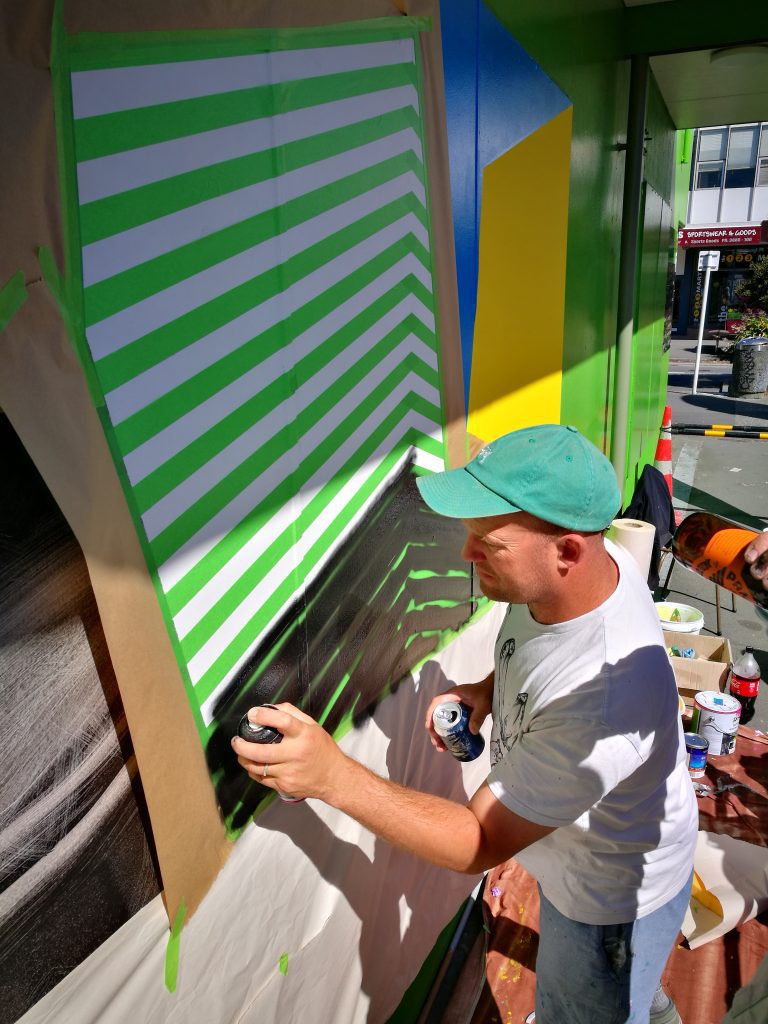
In a way, that brings us full circle to where we started: you got to use your painting skills, cutting in, masking off, to help someone out…
Yeah, I’m stoked when those skills are useful, I think that’s where my talents maybe really lie!
I think everybody knows you’re a man of many talents! So, what is coming up in the next few months?
I am going to be part of Stoked, which is an exhibition of surf-inspired art as part of the Duke Festival in New Brighton, and then we have a Fiksate show, Visitors, at The Welder on the 16th March, which should be good times, New Brighton comes to the city! Come and check it out!
Cheers Porta!
Visitors opens at The Welder on Welles Street on Friday, March 16, at 5:30pm. Alongside Porta, Visitors also features work by Jen, Dr Suits, Bols and MFC Lowt.
Follow Porta on Instagram
Jacob Root – So Much Fun
As part of a new ongoing series of interviews with young (and young at heart) local artists who have been a part of, or influenced by graffiti and street art, we caught up with young stencil artist Jacob Root, aka Distranged Design. The diversity of the city’s young creatives is notable, but the influence of urban art is undeniable in the work of many, either evident in techniques, material approaches, conceptual ethos, or of course, although not exclusively, by the explicit act of working in the streets.
Jacob’s work has been undeniably influenced by the global rise of urban art and locally by the emergence of graffiti and street art’s popularity and visibility. While he does not have a background in graffiti writing, his work illustrates the way urban art has become an established visual language and gateway for young creatives both inside and outside, raising questions about the notions of ‘authentic production’ and highlighting the evolving landscape of this cultural phenomenon. His choice to use employ stencils is fitting, as the technique is a microcosm of sorts of these winds of change, the guerrilla political roots are still inherent, but they now exist alongside intricately detailed studio productions and large-scale murals.
Jacob’s eagerness is infectious and refreshing. When we sat down to talk, his responses were littered with phrases like ‘it was so much fun’ or ‘it’s awesome’, signs that he is enjoying making art and the experiences it has afforded him so far. In a world where cynicism is often too easy to embrace, Jacob Root is busy having ‘so much fun’…
So, Jacob, introduce yourself, let people know who you are and what you do…
My name’s Jacob Root and I’m a 17-year-old design student at ARA. I’ve been teaching myself recently how to do my own artwork, like I can’t really hand paint or things like that, so I’ve gone with the whole stencil approach and it’s kind of kicked off a bit, I’m pretty stoked on how it’s been looking…
You’ve definitely been visible, you have recently had work in several exhibitions, you’ve been busy painting Chorus boxes, and you’ve also been assisting some other artists on their projects, so give us a bit more information on what has been keeping you busy…
Recently its been the Chorus project, which are the big cabinets, the green boxes around the place. I got asked to do two of those to spruce up an area in Gayhurst Road. I was pretty stoked to get asked to do that, I wasn’t really expecting anything like that to come along, but yeah, its been awesome doing bigger pieces, bigger stencil works. It’s so much more fun to work on that bigger scale.
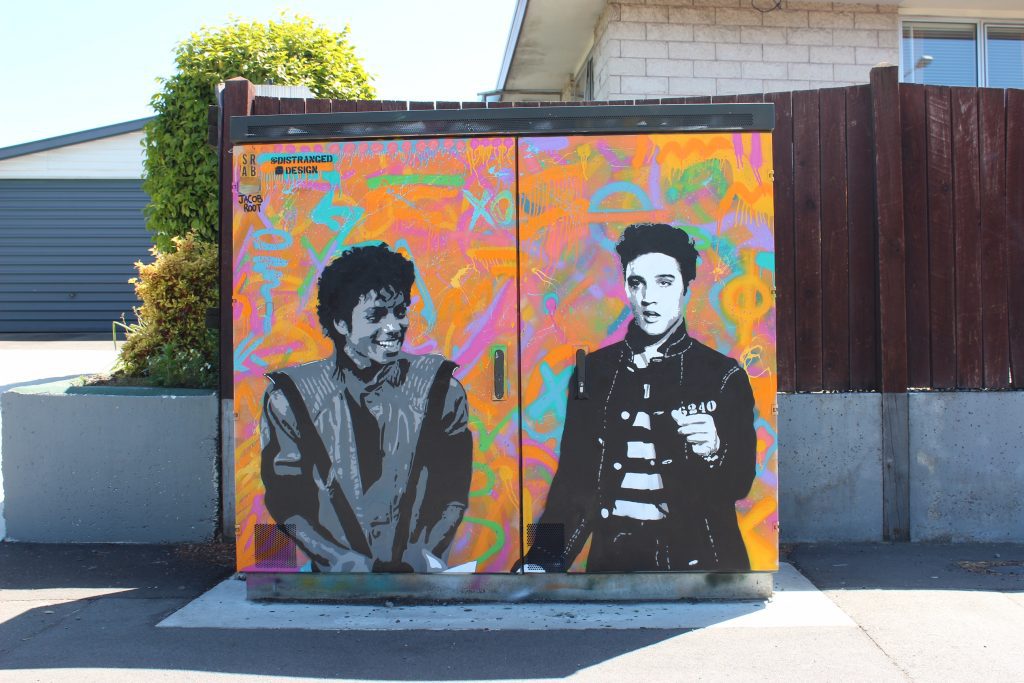
And you’ve worked with Joel Hart on a couple of his pieces, how have you found that experience?
That’s awesome aye, it’ so cool, Joel’s such a nice guy. It’s so much fun learning different approaches to things that I wouldn’t have thought about doing, different ideas on stencil work. So yeah, it’s so cool.

And of course, you have been exhibiting your work, you have been in a couple of shows at the Welder Collective [Jacob was part of the Welder shows Unframed and Throwback], and you’ve got some work in a show coming up in a show at CoCA, tell us about that show…
The CoCA show is run by Bounce, by the Red Cross [Bounce is a website focused on youth well-being], and it’s a youth exhibition, so it’s for 25 year olds and under, and I’ve got a couple of pieces that will be exhibited there, I’m pretty happy to be asked to go in there…
Are you from Christchurch? Are you born and raised in Christchurch?
Yep, born and raised in Christchurch, I’ve been here my whole life…
So you’ve obviously been here through a pretty chaotic but fascinating time period, and especially for the rise of urban art. So, at your age, the experience of the city being rebuilt, it must have been a pretty formative period for you right? How much of an influence has this post-quake landscape and the visibility of urban art had on your work?
I love like, just going through town now, everywhere you look, there’s so much street art. It’s just such a bright, vibrant kind of place to come through, even though like its had its dark toll on the city, there’s been a spruce up with the art and I reckon that its kind of like bringing it back to life, it’s been awesome. It’s such an impact seeing top artists like Owen Dippie, I love his big ballerina piece [the now obscured piece on the rear of the Isaac Theatre Royal], seeing that kind of stuff in your own city, it just gives you a bit of a kick to keep going for more.
Do you have a background in graffiti or street art in a traditional sense?
Nah, I can’t write graffiti or any thing like that, I’d be pretty keen to learn, for my backgrounds and stuff…
That’s an interesting point because urban art is now so widespread and ubiquitous, that it’s influence is becoming more diverse, or at least it is showing itself in more ways than just the traditional ways of getting up, and you are kind of an example of that…
Yeah, exactly, I like seeing the pop in the background before a work develops, I like seeing how it just kind of gives it that push forward and then that final piece over the top.
And the urban landscape is an influence? The backgrounds in your work, to me, echo urban environments…
Yeah absolutely, I love the style of SAMO, Jean Michel Basquiat, even though its writing and mine’s not like that, just seeing that out there, just different types of stuff.
There’s an expressionistic quality, right?
Yeah, and I just go with what I feel in my backgrounds, so it’s not going look the same each time.
It’s interesting that with a lot of your work, your pop culture references seem to predate your age. Have you always been fascinated by other generational icons? The likes of Bowie, Basquiat, Monroe, Warhol, these types of figures are influential for everyone I guess, but I would suggest that you would be receiving their influence through different filters…
Yeah, I love seeing the people that have made a mark on cultures in what they’re trying to do in their life. I think that’s a major push for me, just doing icons and things like that, like with the Chorus boxes I decided to go with legends, I did Michael [Jackson] and Elvis [Presley], I thought that was pretty fitting, its my type of style.
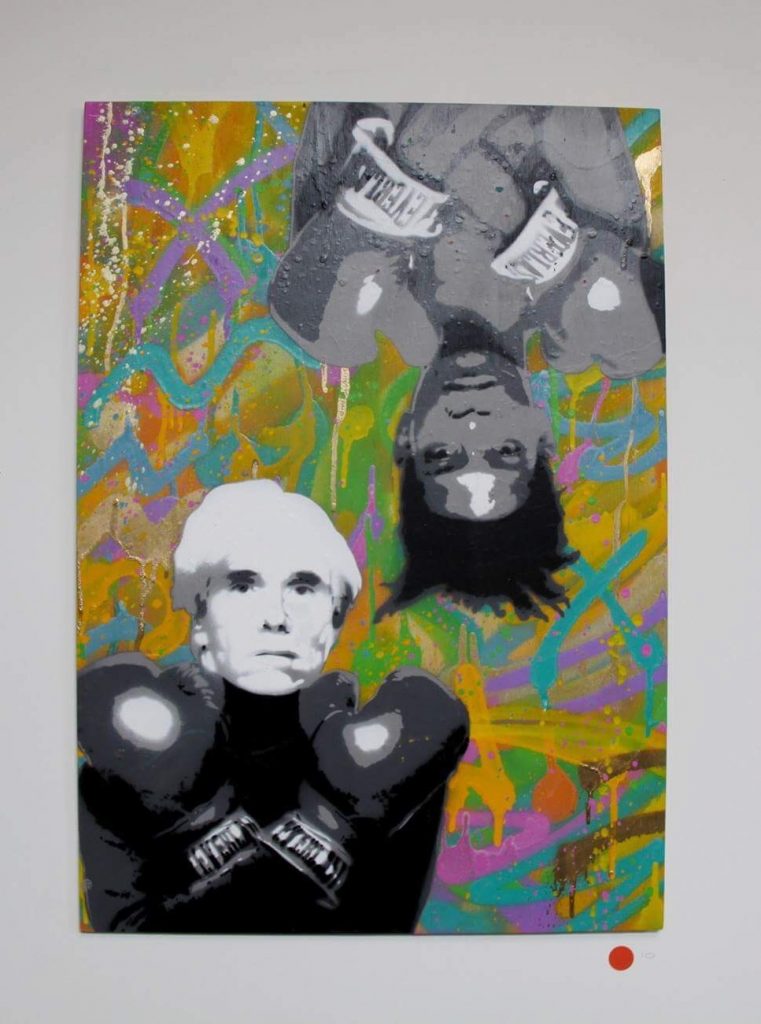
Actually I had a conversation with someone not too long ago, about how stencil artists often seem to begin by producing images of pop culture icons, and you appear to be another example of that. Why do you think that sort of imagery suits the stencil technique and aesthetic in particular?
I think it is just like photographs that are iconic and things like that that people turn into art, I think that’s why people sort of turn to that style, or at least that’s why I’ve approached it because it’s cool bringing those photos back into perspective for other people.
There’s a transformative element too when you are creating a stencil, you are essentially reducing the image and then recreating it, so there’s a different approach than a photograph…
Yeah, it’s kind of like working from the background, back to front. It’s been fun learning stencils and learning all that process and trying different things.
Any particular influences in terms of stencil techniques or the aesthetic you’ve developed?
I’ve only just really started looking at other people’s work that has influenced mine, but it has been people like Alec Monopoly and Tristan Eaton, and Rone, even though some of them aren’t stencil artists, their kind of work is what I look at and I think, that’s awesome, that’s sick. Tristan Eaton’s work is just so intricate, just the pop, that’s kind of what I look for in street art, brightening up a certain area, if that’s what you’re getting asked to do…
So your goal would be to start doing bigger walls?
Oh yeah, I’d definitely be keen to start doing some bigger pieces, it’s so much fun working on a bigger scale…
Obviously it produces a lot of challenges, and working with Joel [Hart] would help to start to overcome some of those, or at least to think about challenges that come up. What challenges has the stencil technique already thrown up and how has your mindset developed the ability to problem solve?
Even just doing the Chorus boxes, printing the stencil plates to the right size was a challenge, connecting the pieces of A3 paper to get them the exact same scale and stuff for each layer, because otherwise its gonna throw the piece out. But Joel’s taught me a lot, doing the Welles Street mural and it has been awesome kind of putting that to use in my own work, it’s been sick, it’s been so much fun.
How do you break down the process from cutting to spraying a stencil? Do you always start with the image, or is the actual technique of putting an image together in an almost mechanical approach sometimes a stylistic influence?
I love doing it because when you see the finished piece it kind of makes it worthwhile, it’s like, you spend all that time cutting, and get hand cramps and all that, when you do smaller pieces, intricate cuts like that, it is worthwhile when it comes together and starts forming a realistic image
In some ways it’s a blind faith right? You are cutting and cutting, and then, at least in the beginning, you are kind of hoping that it comes together…
Yeah, you’re cutting and it’s like, I don’t know why this piece is like this, what’s this piece going look like when it’s cut out, but when you spray it, it’s like ‘oh, I get it now’…
In one of your recent pieces, you experimented with your background layer, where it actually forms part of the central image rather than just a backdrop…
I’m experimenting with that technique because with my backgrounds they can start to look really similar, so I’ve tried to pop stuff to change it, so you know it’s still my art work, but its just different. So, I’m looking at doing a Jimi Hendrix with his suit being that kind of background pop…
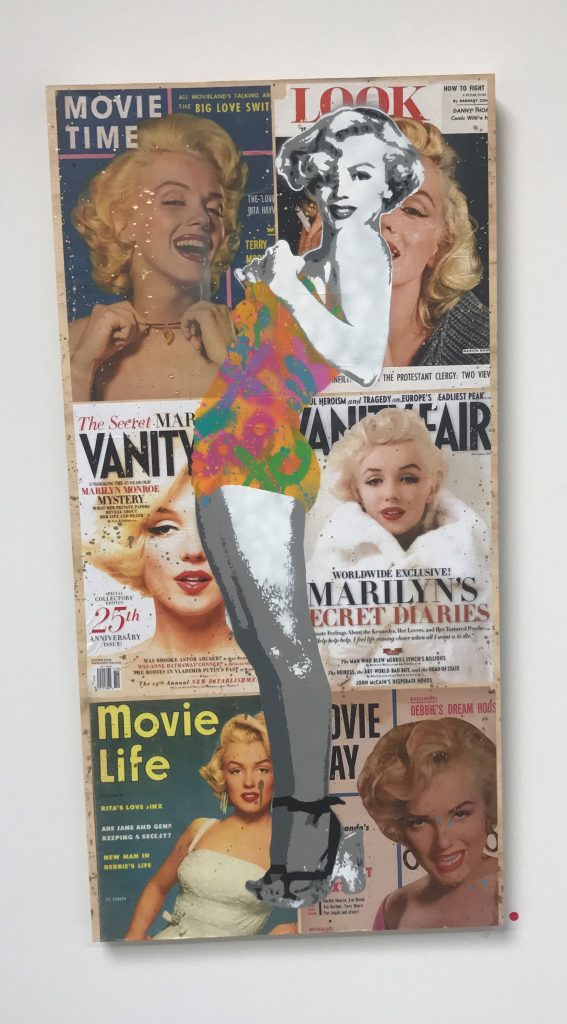
Do you know of Martin Whatson? I assume he is an influence with that approach…
Yeah, he is definitely an influence, his stuff is awesome, his prints and his street stuff, with the graffiti layering and street art style stuff over the top is definitely an influence on why I’ve gone in that direction. I’m keen to do some other pieces like that…
On a personal level, who has been particularly helpful in your development?
My parents have been the best, they’re awesome. I’ve turned Dad’s brewing shed into my studio and basically that’s where I go and spray and do all my painting and things like that. And definitely Joel, he has helped a lot. He’s such a cool guy, I’m just thankful that he has taken time to come and help me, like it’s so cool just being able to work other artists, like even going into the Welder and everybody’s like so genuine, they like what they are doing and they are happy to help other people, it’s sick.
What does the future hold for you? What are your goals and how do you see what you’re doing now progressing?
My goal would definitely be to try and turn my art into a career, I’m pretty keen to do my Bachelors (Degree) so I have a back-up if that doesn’t quite go to plan, but it’s definitely what I want to go with because I’ve started to lose a bit of interest in studies as I’ve been doing so many different projects, it’s been so much fun. But, I’m definitely keen to start doing some walls and picking up the scale.
Any plans to travel?
I’m going to Vietnam next year, so I’m pretty keen to arrange something over there while I’m going so I could do a piece there, that would be pretty sick. I’ve never done something out of Christchurch. In Venice Beach [in California] you can just go and paint the walls and things just right next to the skate park, and I’ve heard that there’s apparently this beach in Vietnam that’s the same kind of thing, same kind of situation, you can just go and anybody can paint them, so that would be pretty cool, going and chucking up a piece there…
Anything else that you want to add?
I’m loving anybody that has anything to do with my art over the last eight months or so, I just want to say thanks, its been so much fun, everybody’s been so welcoming. That’s what I’m loving about Christchurch, all the genuine people who are keen to see you keep pushing yourself…
Thanks for chatting to us
Thanks for having me…
A Conversation with Flox
On September 15-16, The Exchange hosted a one-night, one-day pop-up shop, a joint venture between jeweller Cathy Pope, artist and illustrator Ema Frost, and artist (and all-round renaissance woman) Flox. The Auckland-based triumvirate transformed the Waltham space into a unique retail experience, packed with jewellery, clothing, books, prints and original paintings, representing the changing dynamics of our methods of consumption; offering an alternative to both online shopping and the dreary mundanity of monolithic mall culture.
We took the opportunity to speak with Flox about the pop-up shop concept, her experiences travelling and painting at various events and festivals, her stencil process, and her reflections on post-quake Christchurch…
Hi Flox! Welcome back to Christchurch!
Always good to be here!
Tell us about the pop-up event here at the Exchange, and how that came to be…
So, myself, Cathy Pope (a jewellery designer) and Ema Frost, who is another painter/designer, last year we got together to a start a project called the Painted Peacock Project, which took us up to India, where we worked with some kids and painted a mural. Aside from that we’re really great friends. After we came back we just really enjoyed working together, and there’s a lot of really great connections with what we do, so we thought well, let’s try this pop-up idea that we’d been talking about. We’ve since had two pop-ups, we did our first one in Napier and the second one in Tauranga. Both of which were really successful. Luckily for me, the Tauranga one coincided with an event, and it’s quite good when I can tag a pop-up onto a festival or something that I’m in town for anyway, you get an even more fantastic response because you’ve just done this great big thing for their community, and it’s really cool, just that whole give and take thing.
Yeah, absolutely
So it’s fantastic to be here in Christchurch. This is the first time in my entire career actually that I’ve been able to do something at this scale, for Cantabrians. I know I’ve got a lot of fans down here, and a lot of my online purchases are from Christchurch. So, I said to the girls, why don’t we do one in Christchurch? Why don’t we go the extra mile, pack the van up, like pack that shit in, like a Tetris game and just drive it down. So, Ema and I did the road trip down and Cathy and her husband Martin are going to drive the van back and we get to fly home, which is cool…
Sharing it out!
So we’re sharing it, it’s a beautiful kind of sharing philosophy that we have, and at the end of the day, you know, we’re all trying to make a buck and to live off what we’re all passionate about. The pop-up format is a good way to expand audiences and allow for different communities to come and look and touch and feel and have that kind of retail experience. You know online is online. Everyone shops online these days but you can’t beat being able to actually see the piece in the frame, touch it, feel it, lift it up, you know. That’s the thing.
Particularly when they are unique items…
Totally. Even in Auckland, in my showroom, people come in and say, ‘Oh it’s so good to see the stuff!’ And a lot of the pieces, they do get up there in terms of price and I wouldn’t expect people to not want to have a look in the flesh first. So, yeah, I’m super excited about tonight and tomorrow and it looks like we’ve had a really good response online so we’re hoping for a good turn-out.
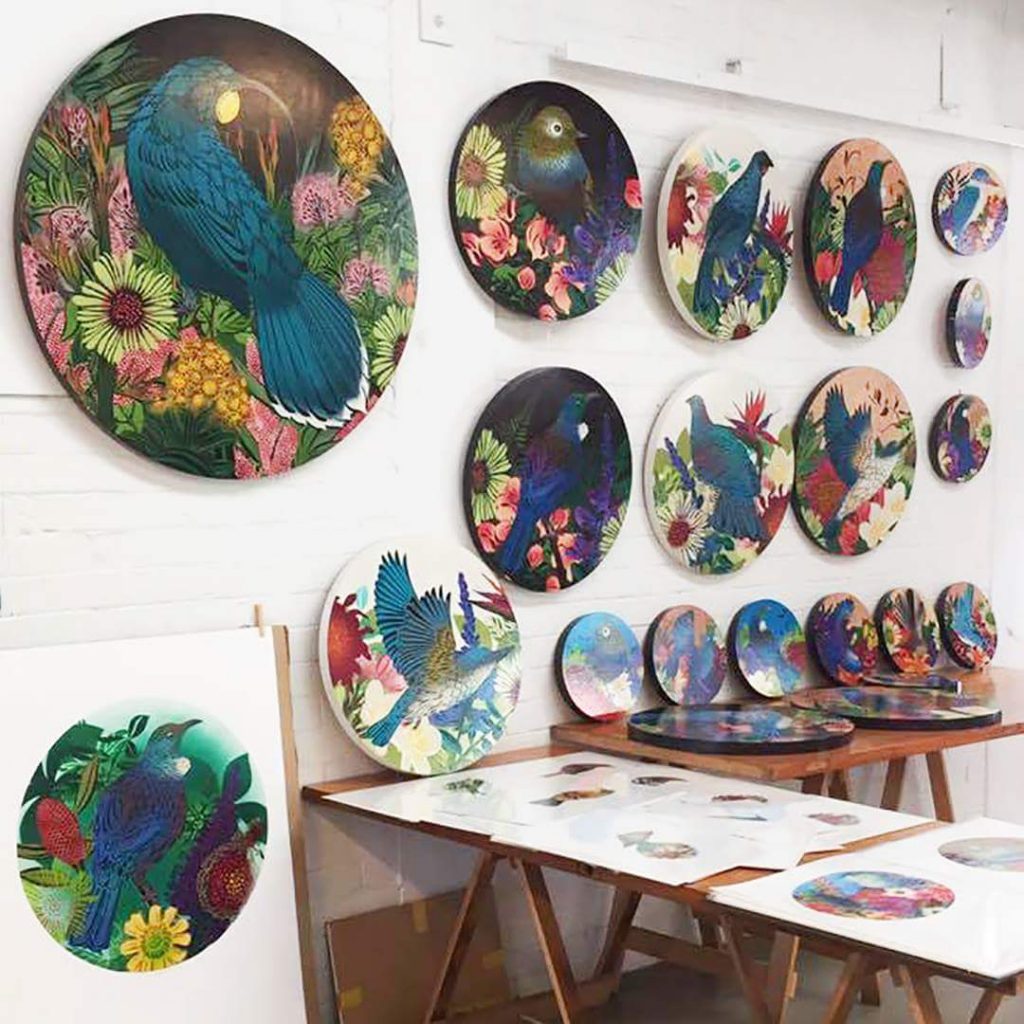
I imagine it will be, Christchurch seems to have developed a better reputation for coming out. There feels like a bit of a sea change, but it’s understandable when for so long there wasn’t much to do…
Absolutely, as you said before, I have been down here a multitude of times in the last ten years and every time, obviously a lot has changed down here, but I go back with this renewed sense of energy, cos so much has changed and I feel like it’s quite motivating. I mean, you guys have been through shit, it’s been hard, but I think now you’re on the other side of it, there’s a lot of positive change, it’s cool to see.
Touch wood!
Touch wood!
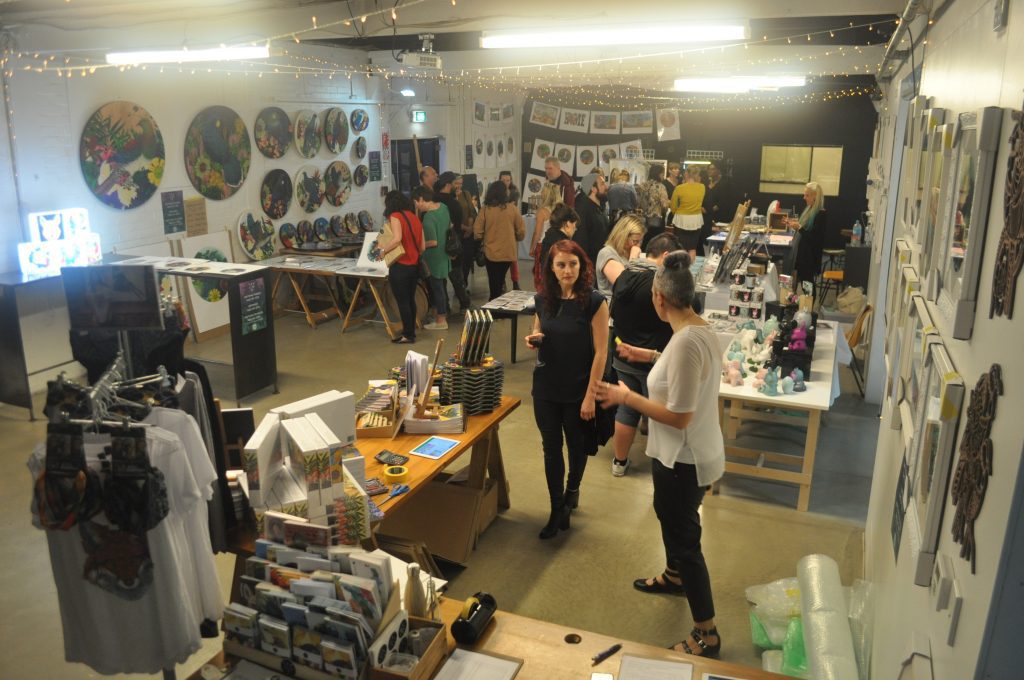
Just going back a little bit, when you talked about the experience in India, and then in Napier, which was the Sea Walls event right? (Sea Walls New Zealand is co-ordinated by artist Cinzah Merkins, and is a tie-in to the international Pangea Seed Foundation events which combine muralism with ocean conservation themes)
Yeah, it was Sea Walls, correct, correct.
Such events are becoming more and more common, where there is a social tie-in to the ever popular street art or mural festival. They obviously present muralism as a vehicle for social commentary and serve as a realisation of the power of these forms. Through your participation what reflections do you have on such events?
Yeah, you know it shows thought and discussion and it really brings a community together, you know, like public art does that anyway, but on top of that we’ve got this incredible theme running through, such as Sea Walls, which is basically marine conservation. We were given a range of topics to choose from. Firstly, it brings communities together because it brings up topics that need be discussed and talked about. But also, from an artist’s point of view, you’re really connecting and you’re really forced to think outside the square and maybe try something new. So you’re growing yourself. You know, with those festivals, personally, every time I paint a mural I want it to be the best I’ve ever painted. So it’s a growing exercise, from a technical and process-driven point of view. But also, the level of communication that you get and feedback from communities is unprecedented. It’s phenomenal.
As opposed to festivals that might undertake discussions about what graffiti and street art are becoming now, these events with social or ecological themes, they move in a different direction, away from the insular reflection and show the inherent ability of these types of expressions to be part of our wider discussions. You know, urban art is often considered rebellious, something people try and solve, but this shows the potential for these cultures to be part of a whole wide range of our communal experiences, which ultimately must be really fulfilling, because I assume ten years ago this wasn’t something you thought would be happening, right?
It’s moving so quickly, like these whole subgenres that are happening and the whole muralism thing, twenty years ago, it was just graffiti, and that had its own origins. But I think fundamentally, when you’re comparing maybe the graffiti world and then this whole street art thing and then the muralism and the festivals, the difference is that I always liken us to the ‘hippy’ artists, the tree huggers, you know, because our intent is to engage, to say ‘Hey come and have a look, I’ve got something to say, and I want you to be able to read it and to have a connection with it.’ I want you to be a part of this genre or this thing that is going on, whereas graffiti was really closed. I wouldn’t have a friggen clue what that said, what they were writing was for those people only, so I think the arms are moving wider and wider, and muralism again is just this whole other thing, it’s just like this huge growth, it’s just blowing up isn’t it?
And it’s raising some really interesting questions around who gets to define and appropriate terms, is post-graffiti/street art/urban art/muralism the same thing? Are they different limbs of the same body? But in many ways its feels like all these arms need to co-exist so that it isn’t co-opted by institutional powers to say this is what this is, and that is one of the dangers I guess, and it’s really important for the sense of ownership and that is why I think artist driven initiatives are so key…
Yeah, I think so, and I think one of the greatest things of any subculture that arises is that it is completely natural and it just comes out of nowhere, you know, and then suddenly you’ve just got this thing, and you’ve got to make a label for it, ‘Quick! What’s it called? What is it?’
Its our human nature to categorise, isn’t it? Recently I was talking to some students about Christchurch’s post-quake landscape and the changing types of creative expressions and interventions, and one student asked why certain cities have become popular sites for graffiti or street art? And my response was that there are so many reasons, and things happen organically, be it a socio-political influence, a response to the physical setting, or it can be just a group of people coming together at a specific time…
It can be a specific situation, like the earthquake, there are so many reasons. Then you’ve got gentrification, that’s another one…
It is really interesting in Christchurch in the inner city at the moment, you may remember a few years ago it was much more haphazard, but you’ve got more and more of these shiny glass facades popping up, and it’s changing the landscape. It is quite interesting to think about what the response might be, there’s room for some really cool guerrilla projects because that physical surrounding is such a big driver of how artists respond to areas.
Absolutely, it’s about using what’s there too, looking for those opportunities.
So when you visit other cities and produce work, how much of that experience of the physical, the social, all those other issues that the actual event that you’re there for, or if you’re just travelling yourself and you get the chance to produce something, how many of those issues come into consideration, I mean is it everything? Or is it often something more personally driven?
Thinking of Taiwan for example, I had the wonderful opportunity to stay there for three months on a residency, so I had the freedom to take my time and create a new body of work and respond to some of their social issues, you know, and also draw on some of the parallels that Taiwan has with New Zealand. So you have those situations where you have freedom and time, and then for me because I work with stencils most of the time, I’m having to pre-plan. So I’m not one of those artists that can rock up, (laughs) like when we did Sea Walls there were 23 artists, and I’d been working for three weeks leading up to it, and then we got there on the first day and I’d say 70 per cent of the artists didn’t know what they were painting! That’s a luxury right there! But I felt really confident because I knew exactly what I was going to do, and I actually like the whole planning thing. It has become almost like a graphic design exercise for me, that’s the challenge. Lately I’ll work really hard on these graphic layouts and Photoshop stuff, and some client driven jobs will require me to do that, but far out the last few walls I’ve done have been really well matched to the brief, so for me the process means that I can’t rock up to a city and, unless I’ve got time, and create a new body of work there and then, or get stuck into a wall. But certainly I like to respond thematically to a locale, and I think that travel has become an integral part of my rollercoaster process. With my practice I get asked to do stuff all the time that may not be as artistically rewarding, and because I’m doing that I have to make sure that I’m well fed, artistically, so I’m doing the festivals and I’m doing the fun stuff, so there’s sort of like two ‘me’s happening at once, and travel is the way in which I come back round to the beginning of that loop and re-influence myself and get that whole new inspiration from new cultures and new locations. For me that’s key, that’s how I work now.
And it just becomes a legacy that you can carry on and build on right?
Totally.
All those experiences feed each other…
And for your audience as well, it shows that you’re constantly on your toes, and you’re moving things along and you’re creating new stuff, and like I said, it’s for me too, otherwise, I’d be bored shitless!
Absolutely! That’s a good transition to talk about your diverse practices. We’ve talked about wall works and murals, but obviously your work ranges from clothing to light boxes to painted panels and beyond, do you think that’s driven by your own explorative nature, or is it tied to the processes you use, or again, is it all of them? Does your approach present constant opportunities to collaborate?
I get asked to do a lot, and now I do a lot of public speaking, and I work with students a lot and I say: ‘I think the best piece of advice I ever got and I’ll pass it on to you guys is that versatility is key.’ In this day and age, when you go to art school and you practice to become a painter, it doesn’t mean that you can’t go off and be a fashion designer or a photographer. I mean, you don’t have to be one thing. I think industries are crossing over in all sorts of ways, and I think that if you can show versatility then that’s essentially keeping doors open. So, yeah that’s always been part of my philosophy, just doing all sorts! (Laughs) But also, if we look at the business side of things, I’ll think: ‘Well, I haven’t really been doing many kitchen splash backs lately, but far out, the private commissions are going off at the moment!’ So it’s sort of like, if somethings not really flying, something else is…
In those commercial elements, say the splashbacks for example, do you find that inspires you to push your work in new directions that may reflect that experience, but without the utilitarian value? Do you find the commercial or practical stuff inspires your more freestyle practices? I’m just thinking that working on that glass surface of a splashback, it must present a range of problems, therefore a range of solutions, therefore a range of possibilities…
Yeah,
Do you find that they overlap quite a lot, do you find them seeping into one another?
Yeah, definitely, there are heaps of cross-overs like that, you’re learning on every job. You’re learning something that you can then take to something else. I mean thirteen years of doing this, you kind of take for granted the level of skill and knowledge you’ve got in your little kete, because it just seems normal. But it wasn’t until I started teaching workshops and I’m like actually, that thing there, you should be teaching them that because I’m just taking that for granted now, it’s just second nature for me. So, yes, there’s all sorts of stuff that crosses over, like you know kitchen splashbacks or outdoor exterior wall stuff for the council, yeah all sorts. I’m constantly learning.
So let me ask about your stencil techniques and processes. I was fascinated when you were here for the 2015 Spectrum show, I had the chance to see the show being put together, and I will always remember seeing all your plates laid out for your indoor wall work, it was an enduring image for me about the process of creating a larger stencilled work. What are your thoughts on the progression of stencilling, because I look back at the very political lineage, it was about a graphic nature that could be replicated and get out to as many places as possible…
It’s like signwriting almost isn’t it?
Absolutely, and what it did was allow preparation and readability, for images that could be replicated anywhere to suggest a particular message…
Repeated as well, repetitive…
And then from there slowly we’ve seen the rise of processes that sort of lead to the likes of Logan Hicks producing massive works of photorealism…
Highly skilled…
Almost mechanical in precision.
Like it’s gone back to the actual photo, like it is the photo.
What I’m getting to (in a long-winded manner!), is that one aspects I love about your work is the painterly quality, which shows the potential of stencilling as a medium, so it’s not just a way of producing a representation image. There is something beautiful in masking space and exploring negative space.
There is, and that’s the fun part about stencilling. I think my background, when I went through art school, I was really interested in printmaking and there are a lot of principles very similar to stencil creation: positive and negative space, what part you leave and what part you take away, that’s the bottom line of stencilling. But for me, my stencil aesthetic has always been evident. I remember the day that my partner at the time, we were working together in Cut Collective, and I remember when we did our first power box together. I was Flox, just, and I was just dabbling, mucking around with the stencil, and we’d finished it and printed it out flat and looked at it, and he was like, wow, I’ve never seen stencilling that looks like this, this is really unique, it’s really different. And up until then, all we’d really seen was you know, Banksy, and its that whole posturized kind of, very Photoshop looking stencil. And so this, over time, that’s the way in which I make marks, the scalpel is my pencil, so I’m really lucky. I feel like inherently, I have his thing in me that I feel so confident with a scalpel now that I’m really scared of a pencil. Like it’s flipped on me, like I get quite anxious when people say, ‘Can you draw something?’ and I’m like ‘No, I can’t draw anything actually, but I can cut!’ But, yeah, what I love about it is that there’s the whole stencil cutting creation, which is unique to me and because I’ll project up on the wall the image and I’ll draw my rough guidelines, but then really at the end of the day I’m ad-libbing with my scalpel, and that’s my special time, and then the painting part, I still get to be playful and although the stencil is rigid, it is what it is, but I can do all sorts of beautiful shading and splatter, and that whole painterly thing, I can be really creative with that stuff, the under-lying stuff, so there’s the combination of the rigidity of the stencil but also the intuitiveness of the painting process as well. I think that’s quite a nice blend.
And I think it’s often overlooked with the way people approach stencil techniques, they’re thinking blocks, a hard and fast positive/negative concept of form. But when you combine the rigidity of a plate with the amorphous nature of spray paint you get this nice combination…
Yes! You get that nice marriage. It’s funny because people will ask me, like a big bird of mine, how many stencils is that? And its only ever one, so I do all the shading and all the colours, and all that stuff freehand underneath, and then I put my stencil line layer, the top layer, whatever you want to call it, on top and that really confuses people, it seems way more complex than it actually is. But it’s not many layers, its one.
But it is layers of paint.
It is layers of paint. And that’s what I teach, I don’t hide anything, my kaupapa for my workshops is to teach exactly what I do, all my tips and tricks, and I just think, the more you can share the better, and who knows whose coming through? We didn’t really have any role models you know, it was kind of like walking through blindly for those first few years.
Which can be quite freeing right? Like you’re not living up to something, and yet at the same time it can be daunting…
It’s both isn’t it? You don’t really know where you’re going, however yes, it is really liberating.
I’ll stop before we get too far down the rabbit hole! Finally, coming back to Christchurch several times, what is your perception of how the city has changed, both in the obvious physical standpoint, but also compared to other cities? Is it a site of great potential or as some people might suggest, a site of lost opportunity? Which might seem cynical, but rebuilding on such a level is obviously a difficult proposition…
It is and everyone’s always got their perceptions, like one of my best friends, she comes down here a fair amount, to visit her sister in law, or some family member, and I always go on to her about how much I love Christchurch, and every time I come down things are moving and there’s this sense of motivation in the air, and new cafés and restaurants are opening, and she’s like, ‘Really?’ I don’t know if it’s the circles she hangs out in, but it’s just so depressing, but I guess I am part of the creative movement, and I’m surrounding myself with certain types of people, and that is what is motivating, and its up to the person isn’t it? To be a part of whichever part they want to be a part of. But for me, yeah, I’m not sure about missed opportunity, but from what I’ve seen I feel like people are really moving and changing and it feels like there’s a lot of really entrepreneurial types out there.
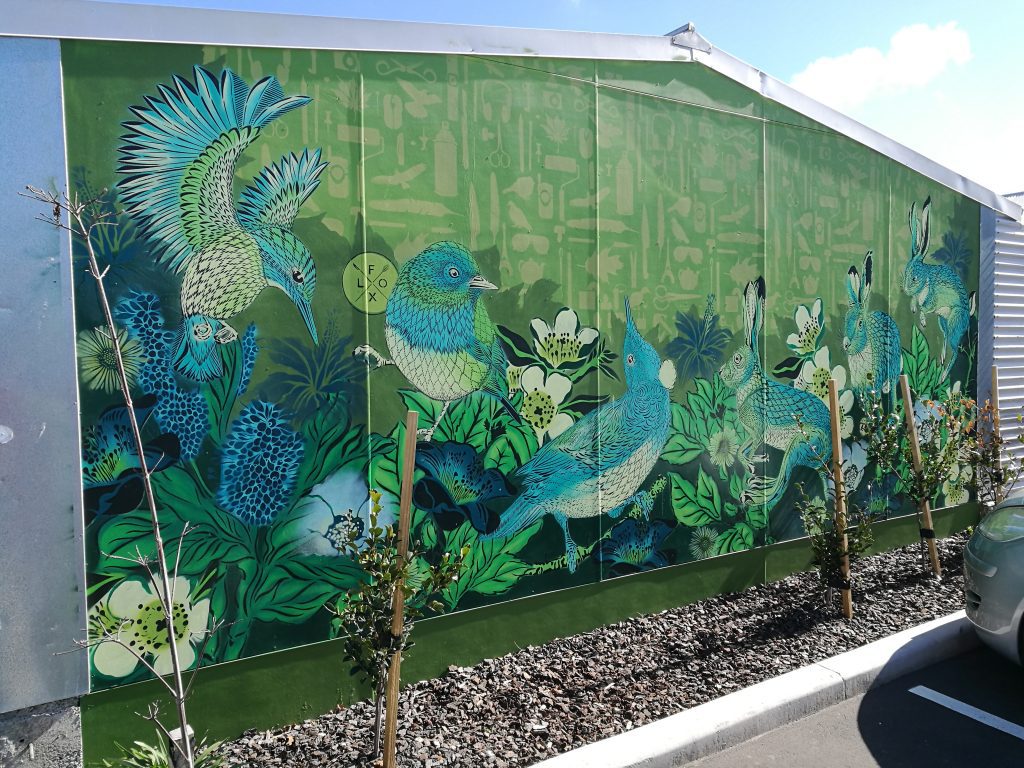
And I think there is an interesting type of entrepreneurship, in that there’s a social element, it’s not just the economic opportunist, it’s the social contribution…
People are a lot friendlier too, I mean compared to Auckland, you know, it’s a lot more open door, and maybe it’s easier to generate networks. But also like you say, for so long, there wasn’t much to do so people are really amped to be a part of something.
I think seeing your city deconstructed imbues in you a willingness to try things, to explore things, an that’s one of the interesting conflicts with the rebuild, you know, as this wild west landscape is disappearing a little bit, that control comes back and it will be interesting to see if that willingness of people to try things, to do things, endures…
I think so, it feels like you’ve got some good planning in place, I don’t know the ins and outs, but I’d like to think we in an era now where people are actually thinking about these things, it’s not the nineties, so I don’t know, touch wood right?
That’s right, as wishy-washy as its sounds, it’s a journey everyone’s on, and everyone’s experience is going to be slightly different as well.
That’s very true. Like we were just saying before, like imagine if we had a place like this (The Exchange) in Auckland? Obviously Auckland’s got its own problems, it is so widespread that it’s very difficult to create those cool little networks, those communities. In saying that, I’m right in Greylynn, so I do have that to a certain degree, but still. Not to mention, the price, the cost of rent, to have something like this you’d have to be a millionaire, times two!
It’s quite interesting to walk out of this space into the surrounding industrial area…
Yeah, I like that!
And yet, you’re still a stone’s throw from the central city…
It’s just there! It’s only five minutes! I like that and I hope these places survive through the build…
Definitely, it will be telling to see what legacies remain, and which are cast aside. And as I say, I hope the majority of people are willing to embrace ideas that have been borne of the challenges of the whole experience.
Like they’re genuine to that right?
Yeah, part of an attitude that has become fortified by this whole thing. Thanks for speaking to us! I’m looking forward to your pop-up, I’m sure you have a lot to do before the opening, so I will let you get back to it!
Thank you!
Find out where to see Flox’s mural in Christchurch on Watch This Space’s interactive map here or find out more about what Flox is up to on her Facebook page.
Did you like like this interview and want to see more of this from Watch This Space? Please leave a comment below. We’d love to hear from you!

